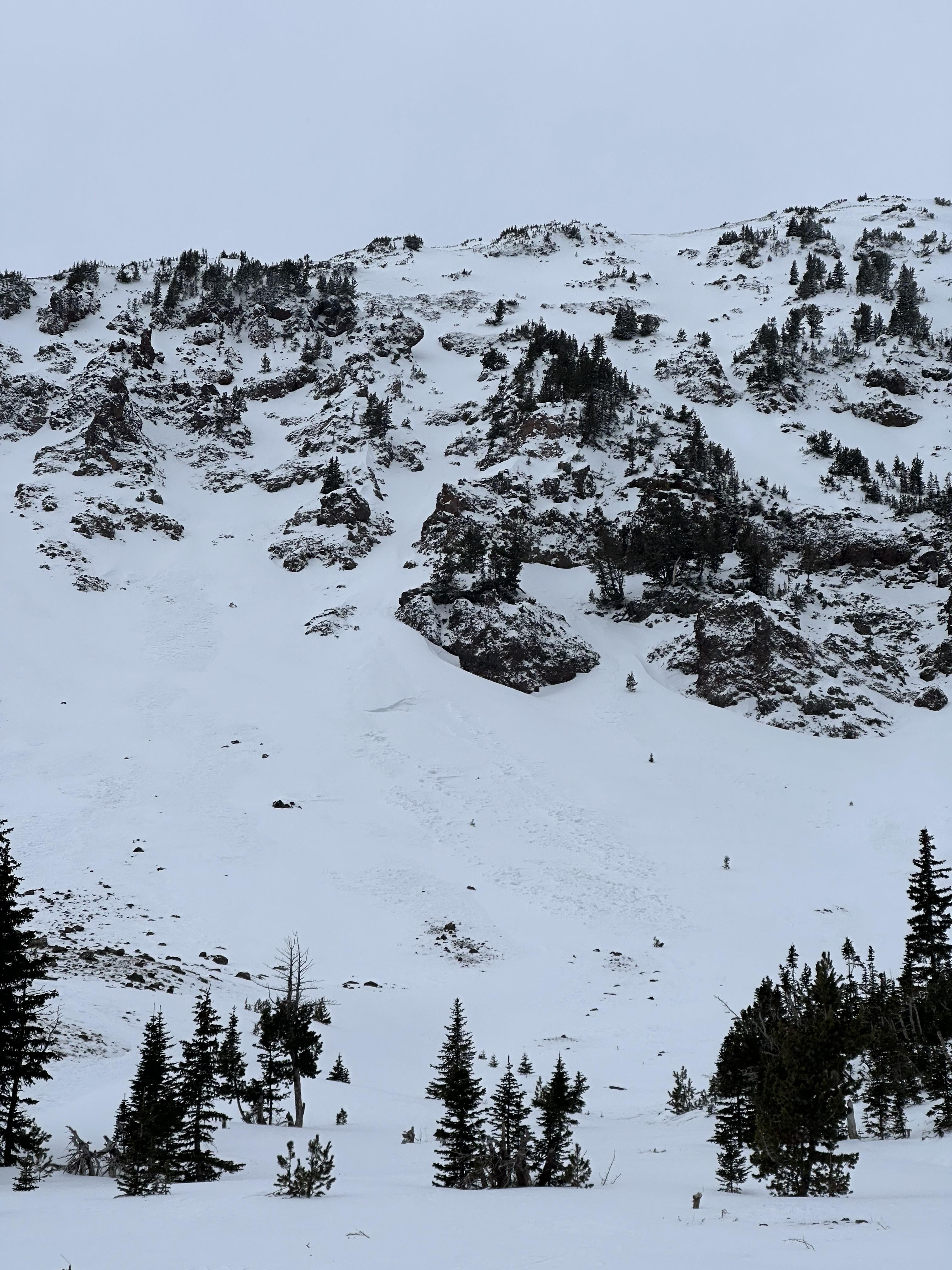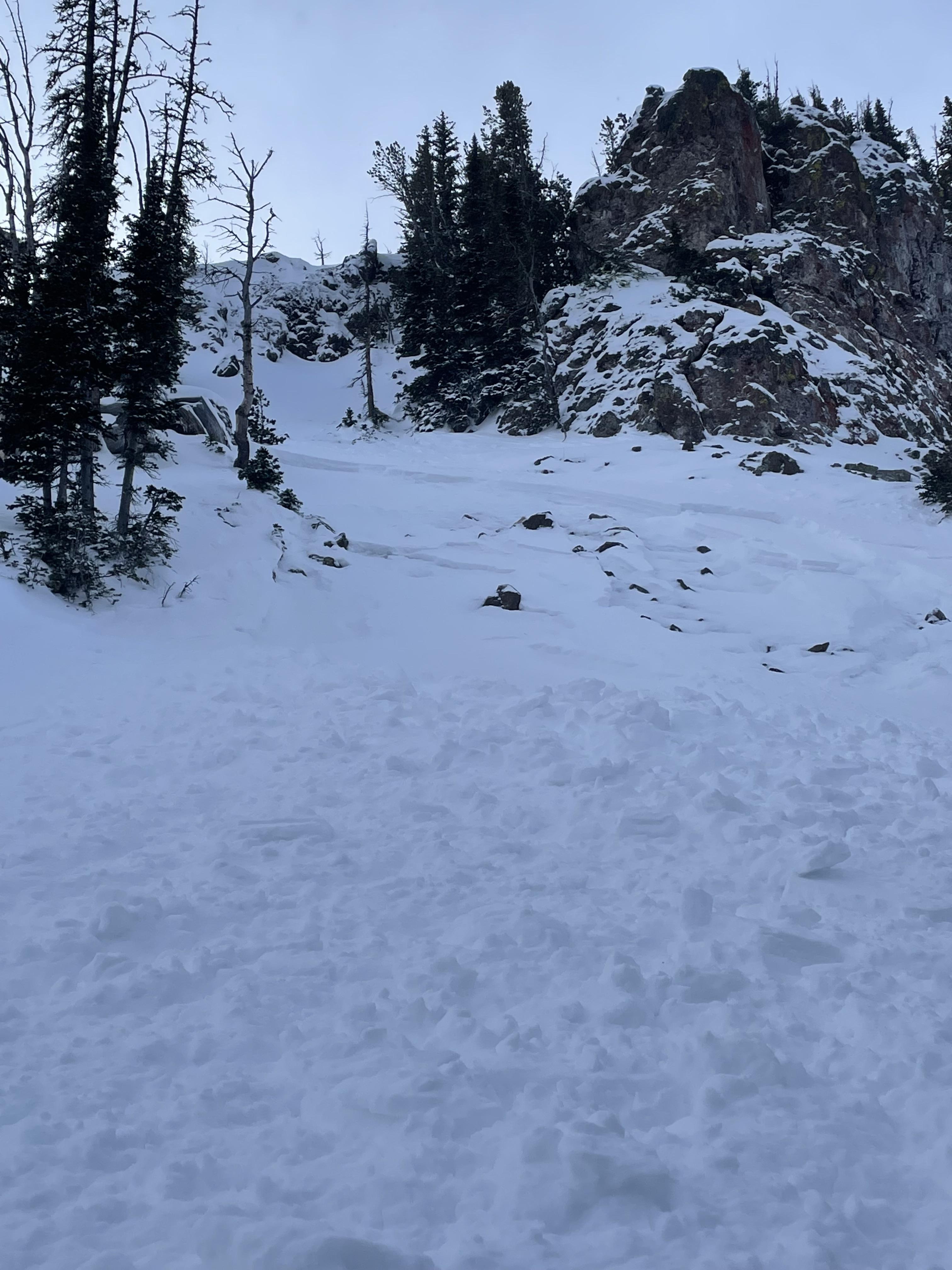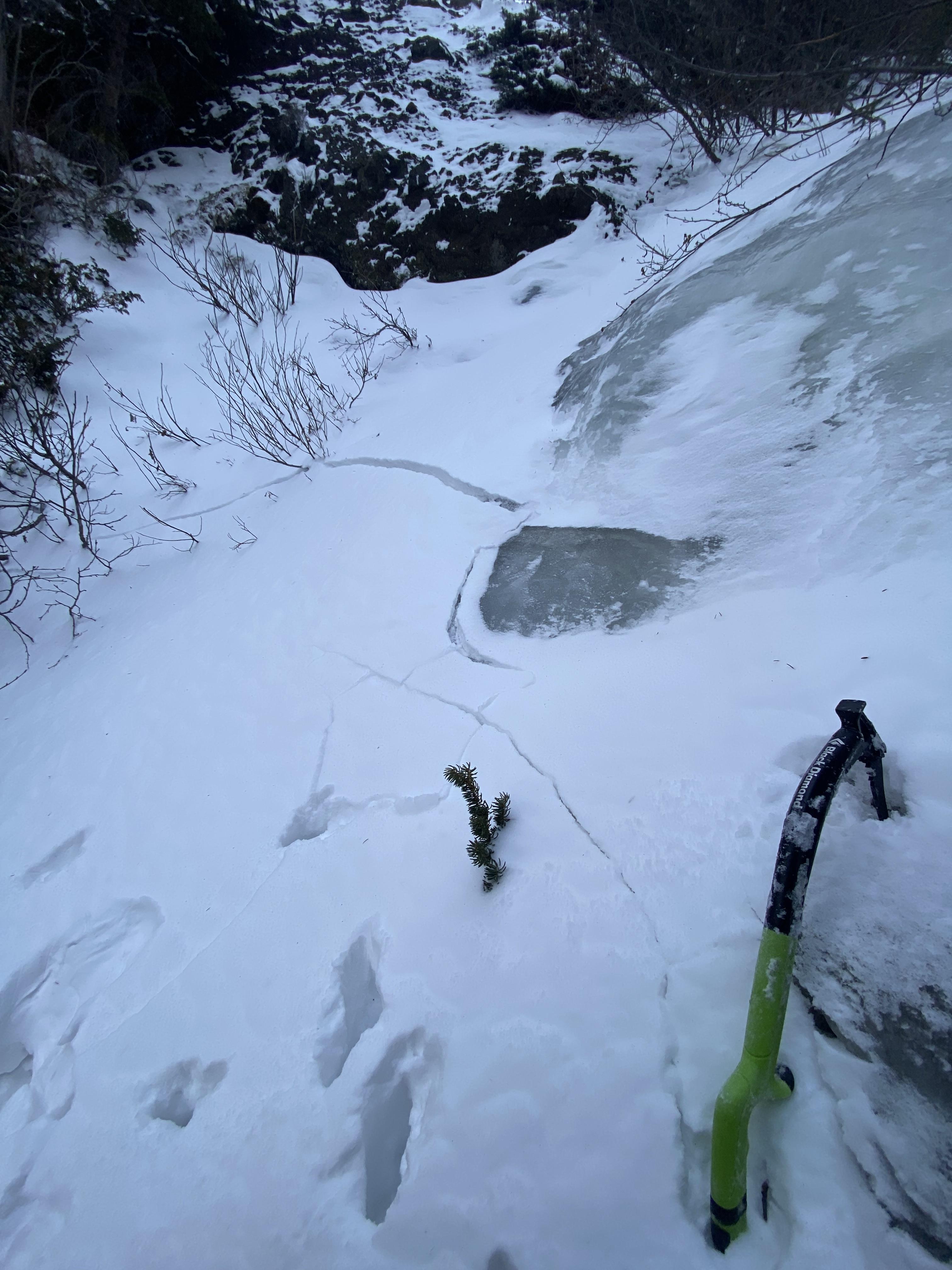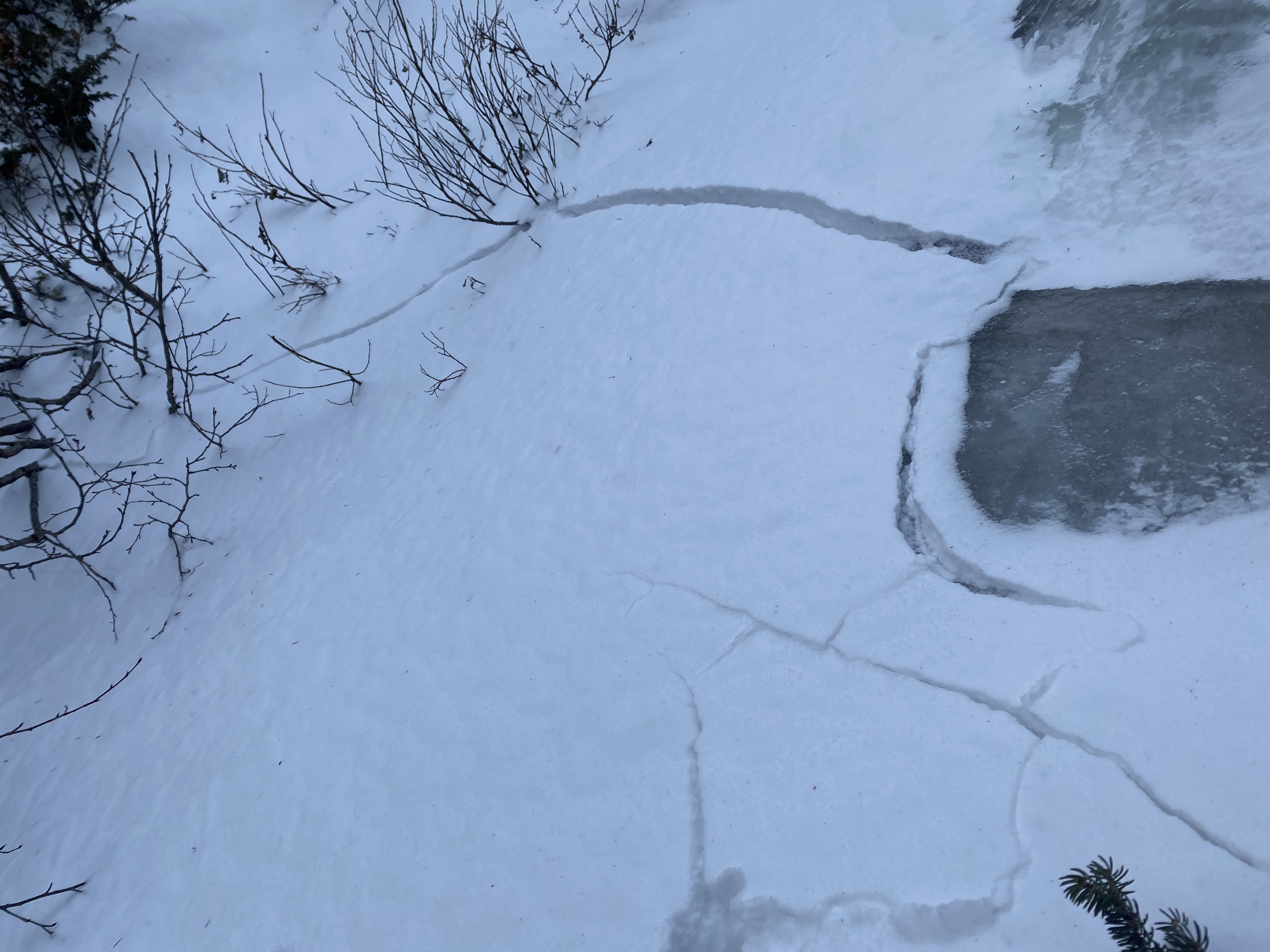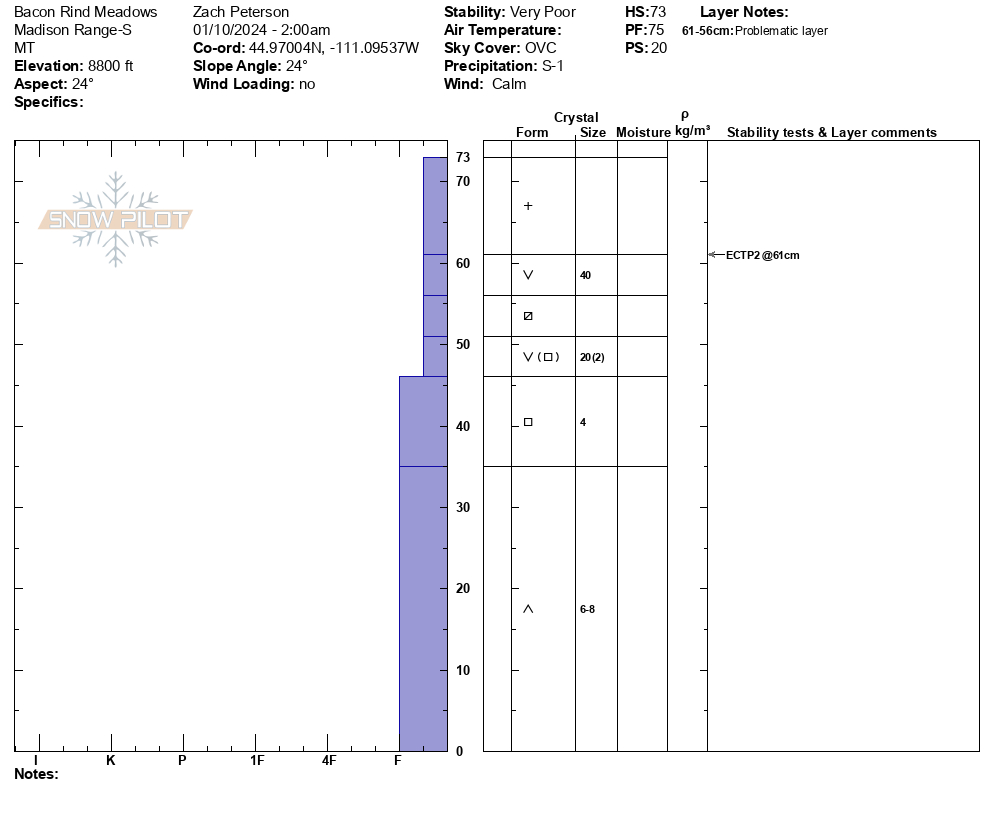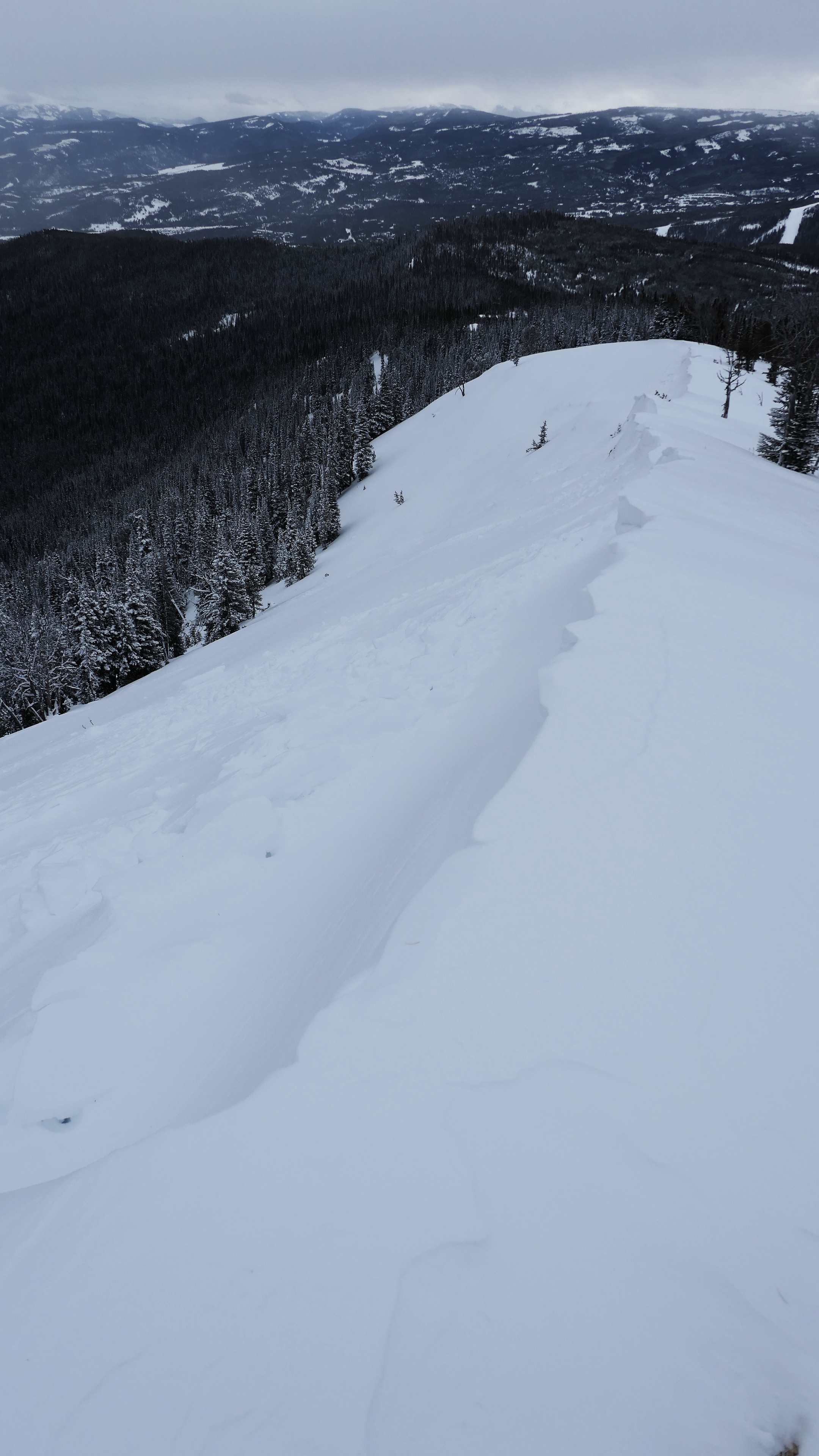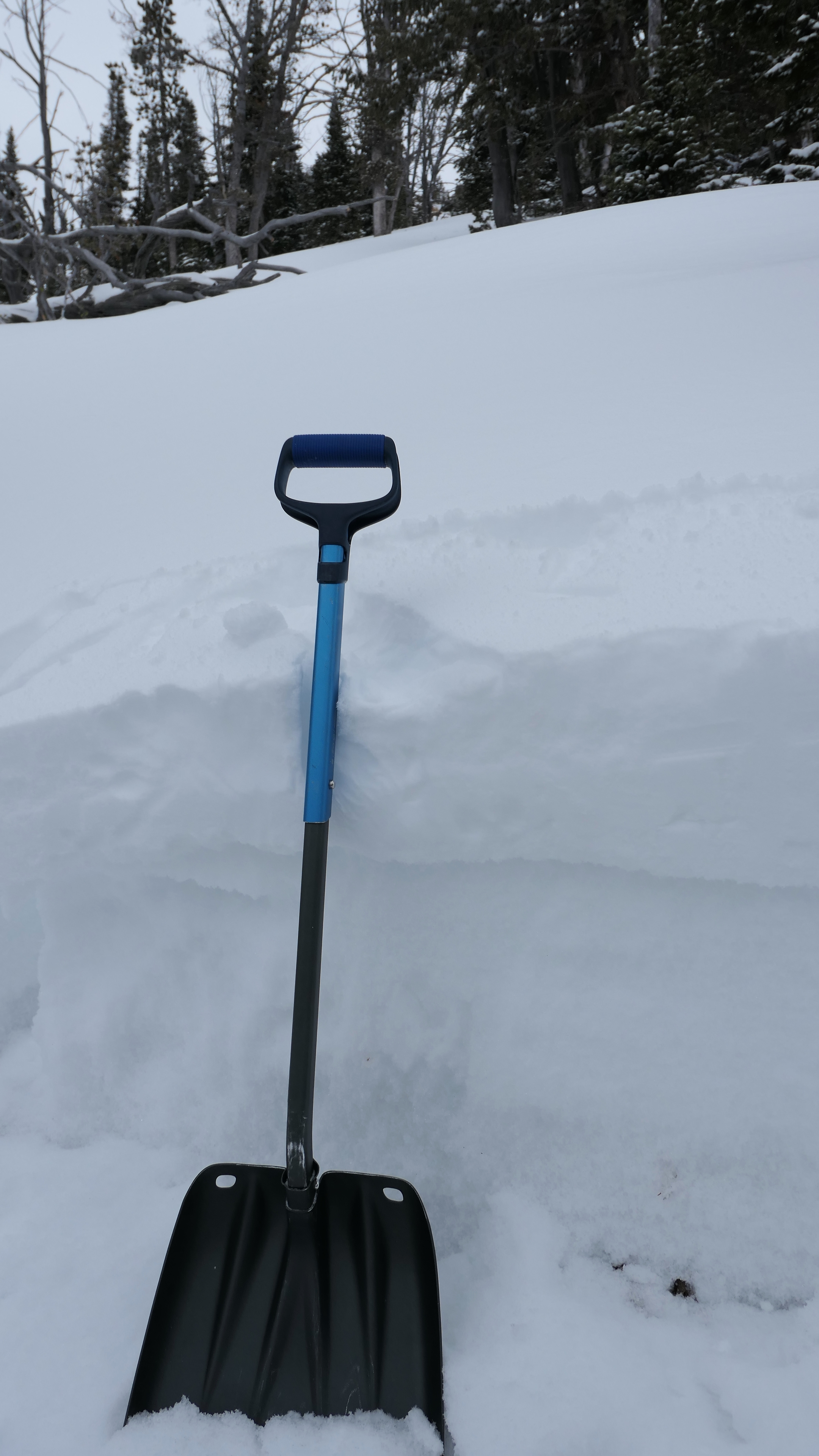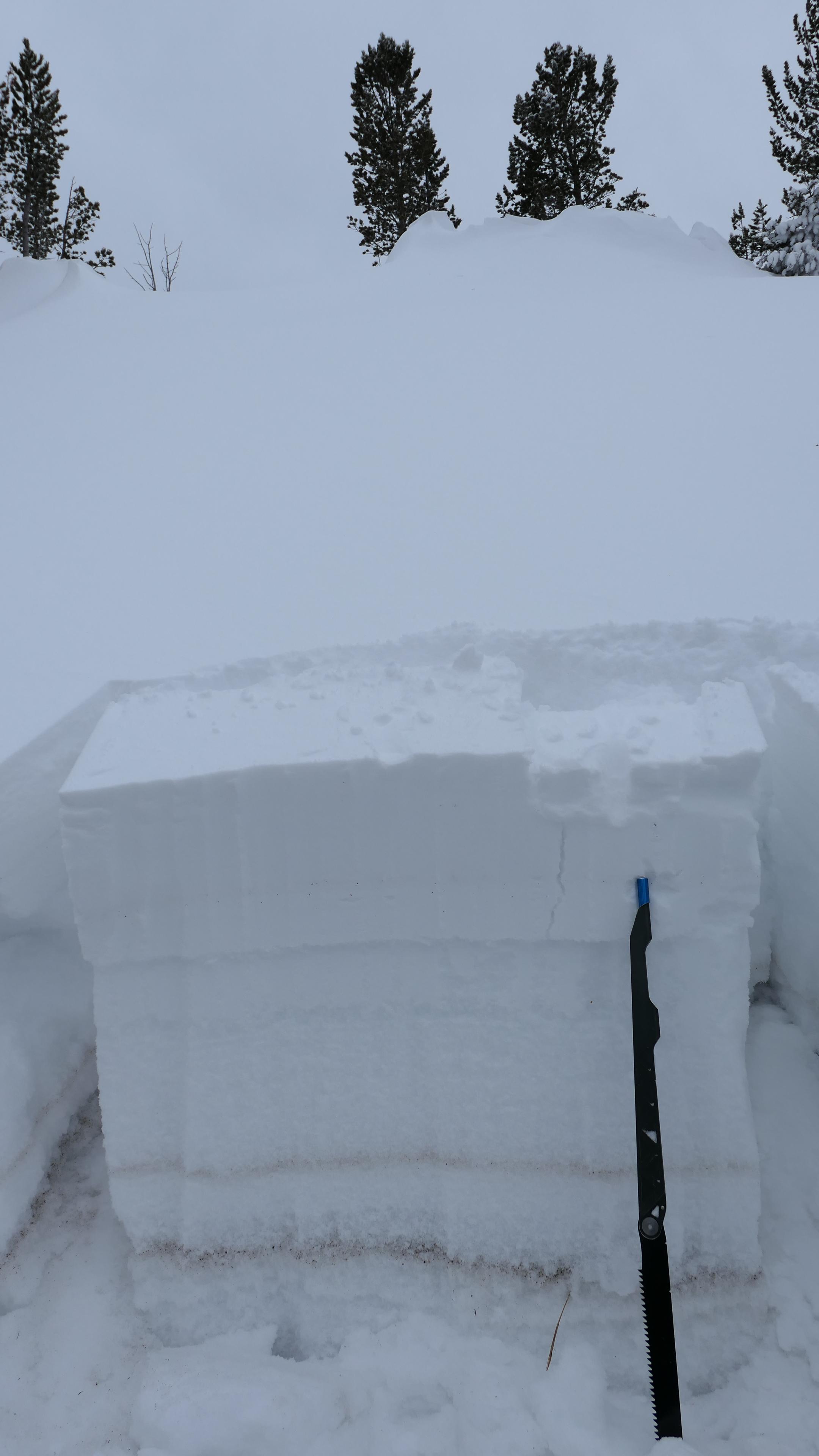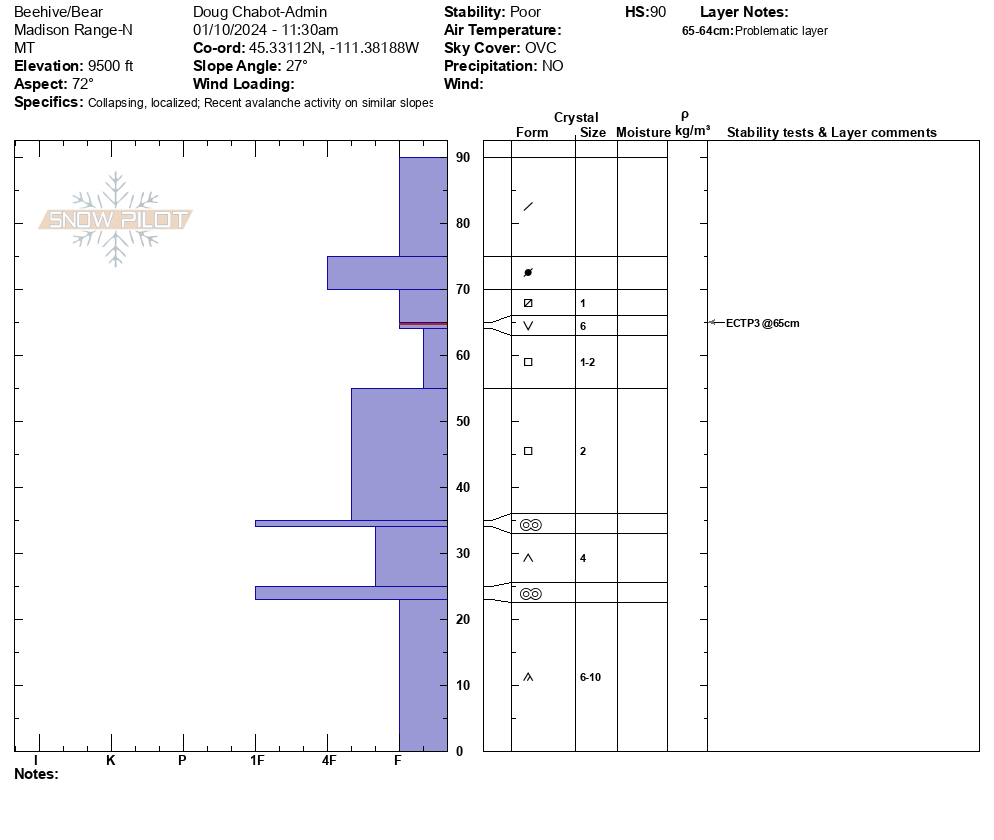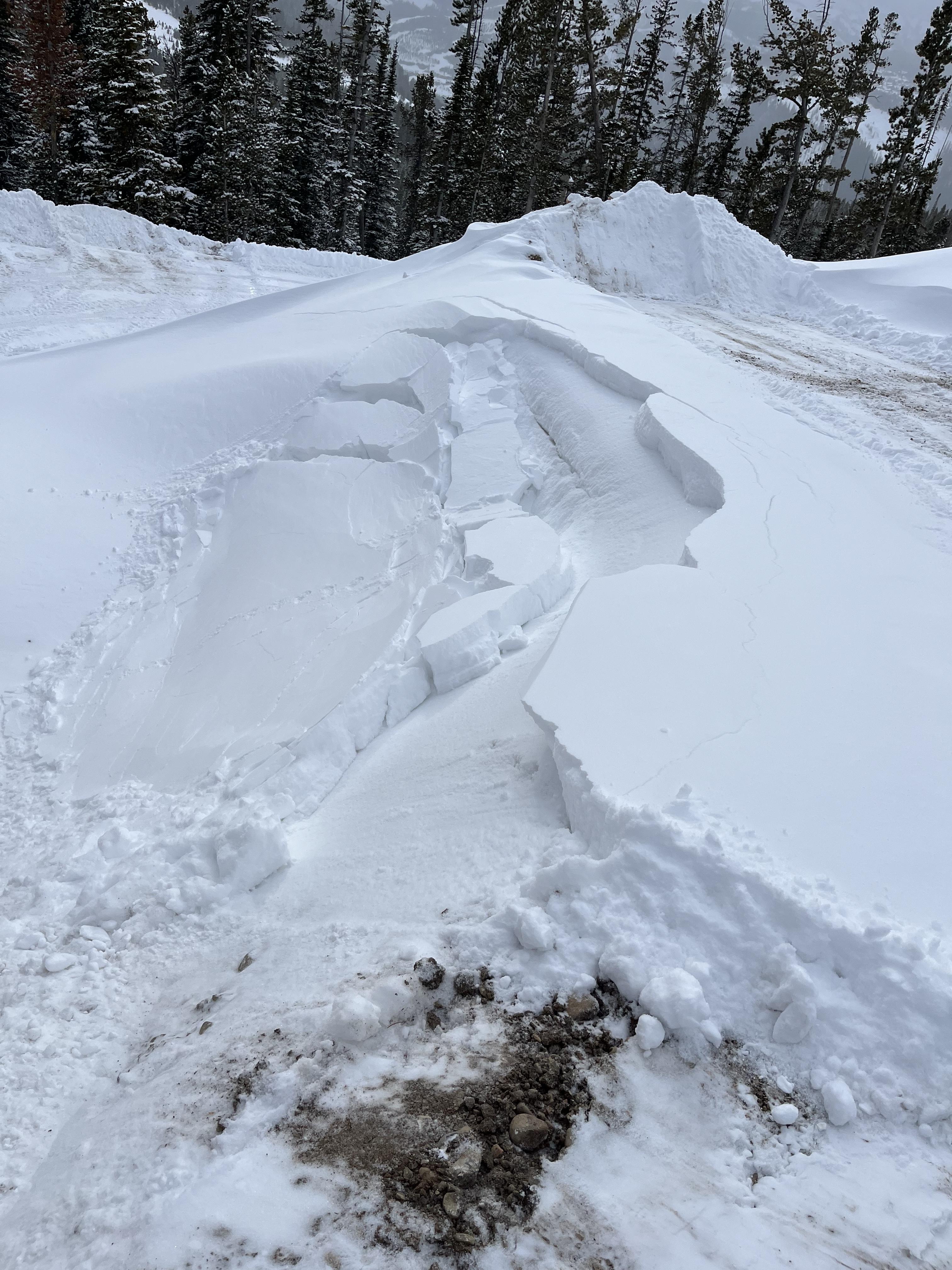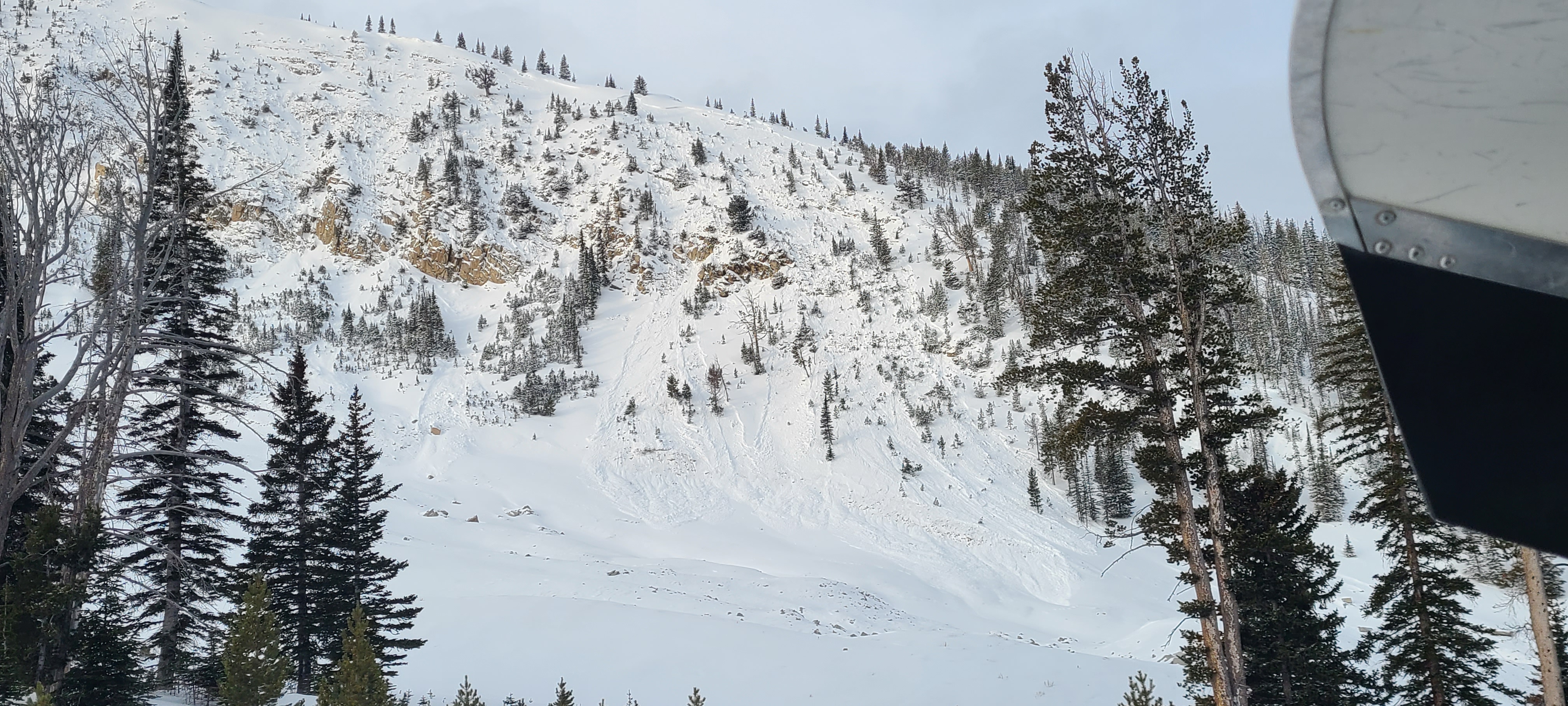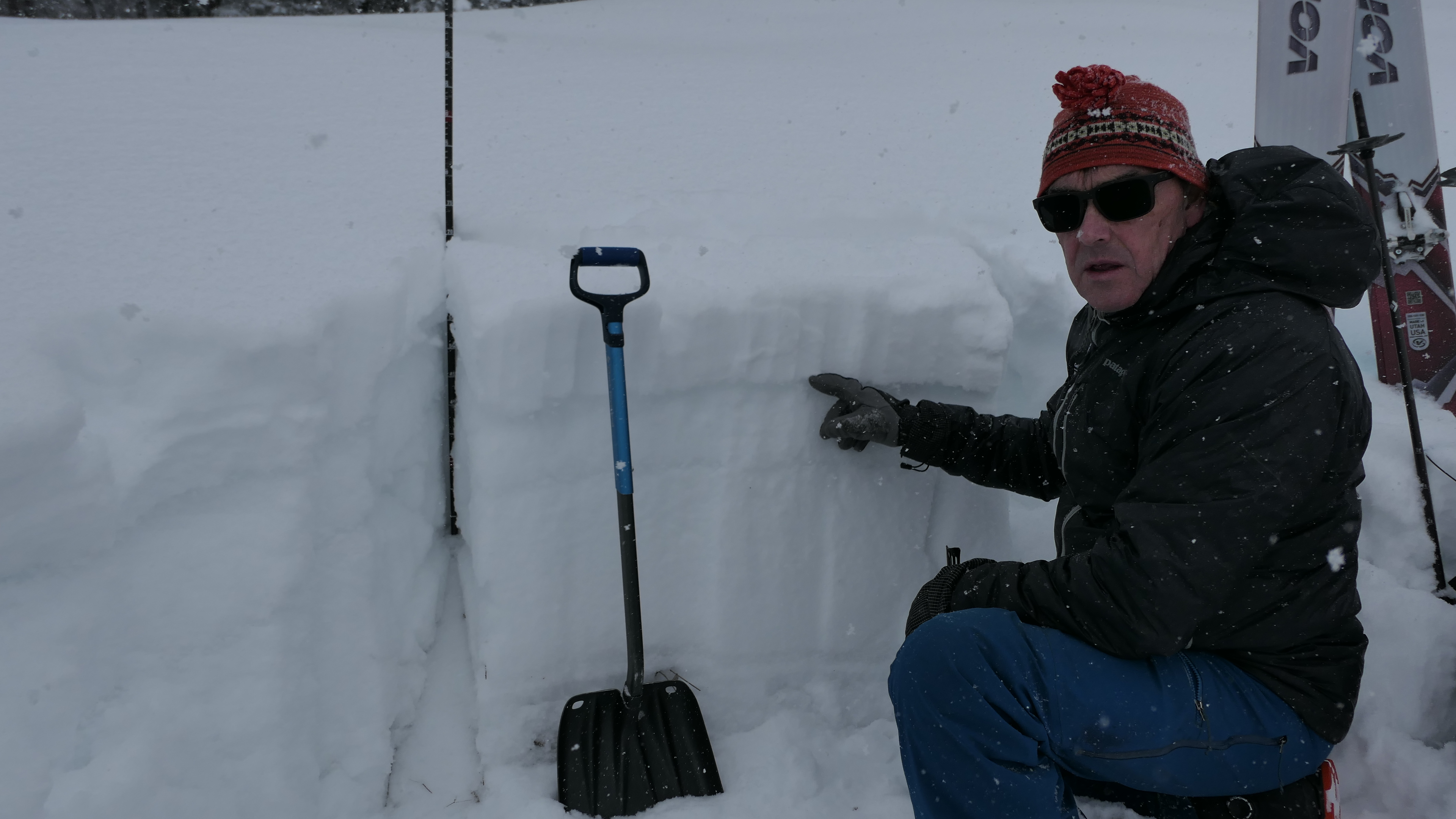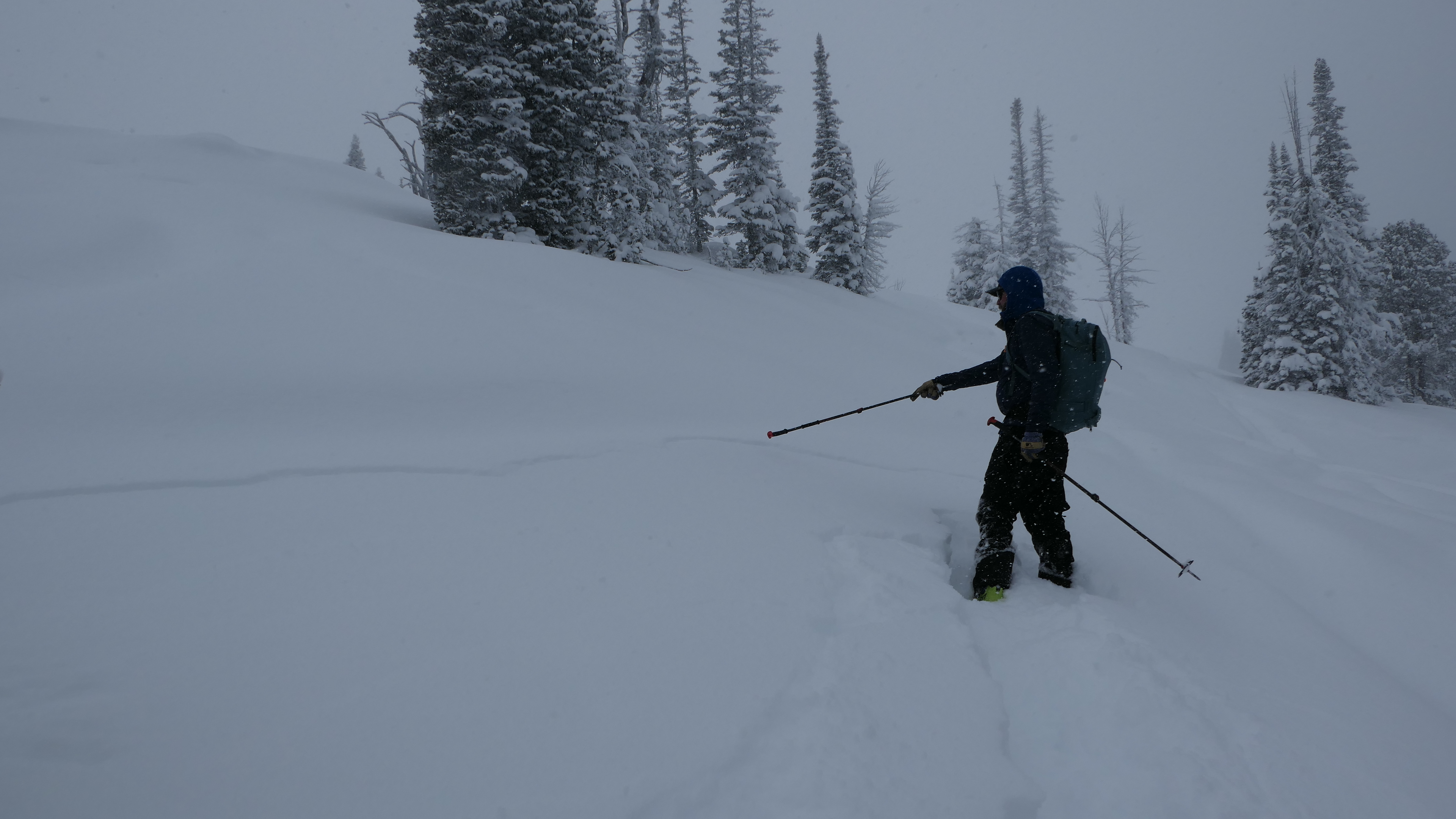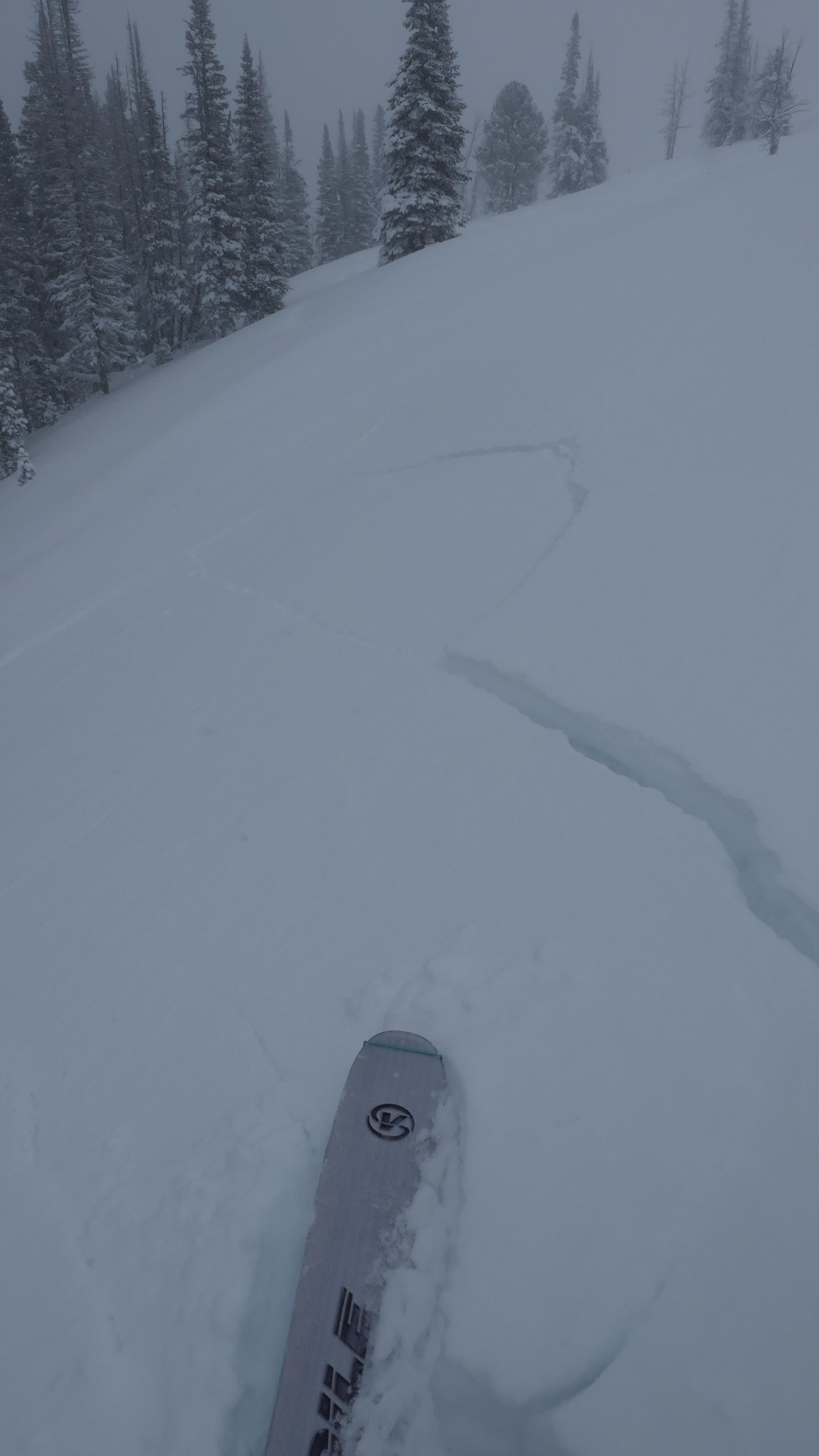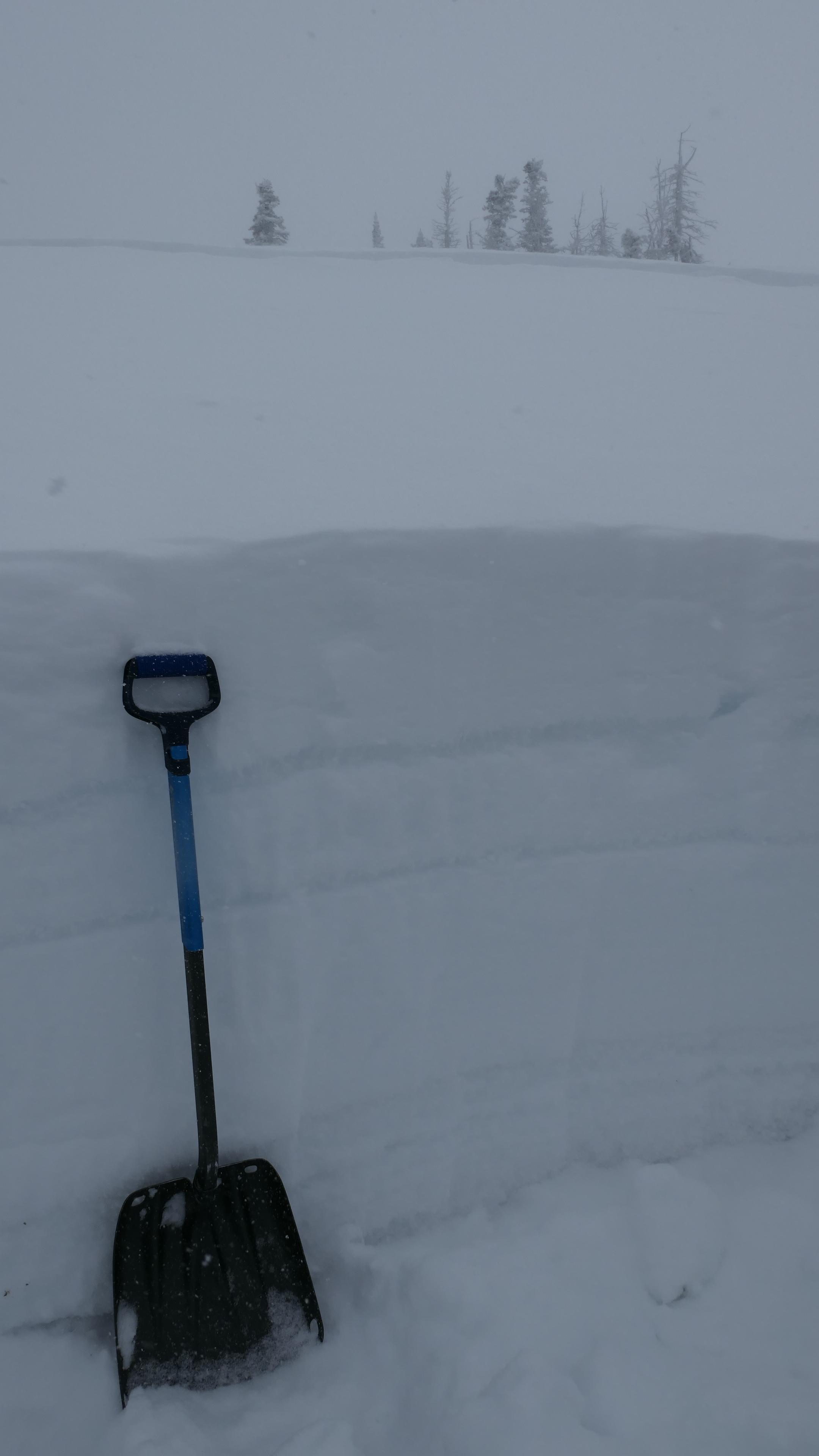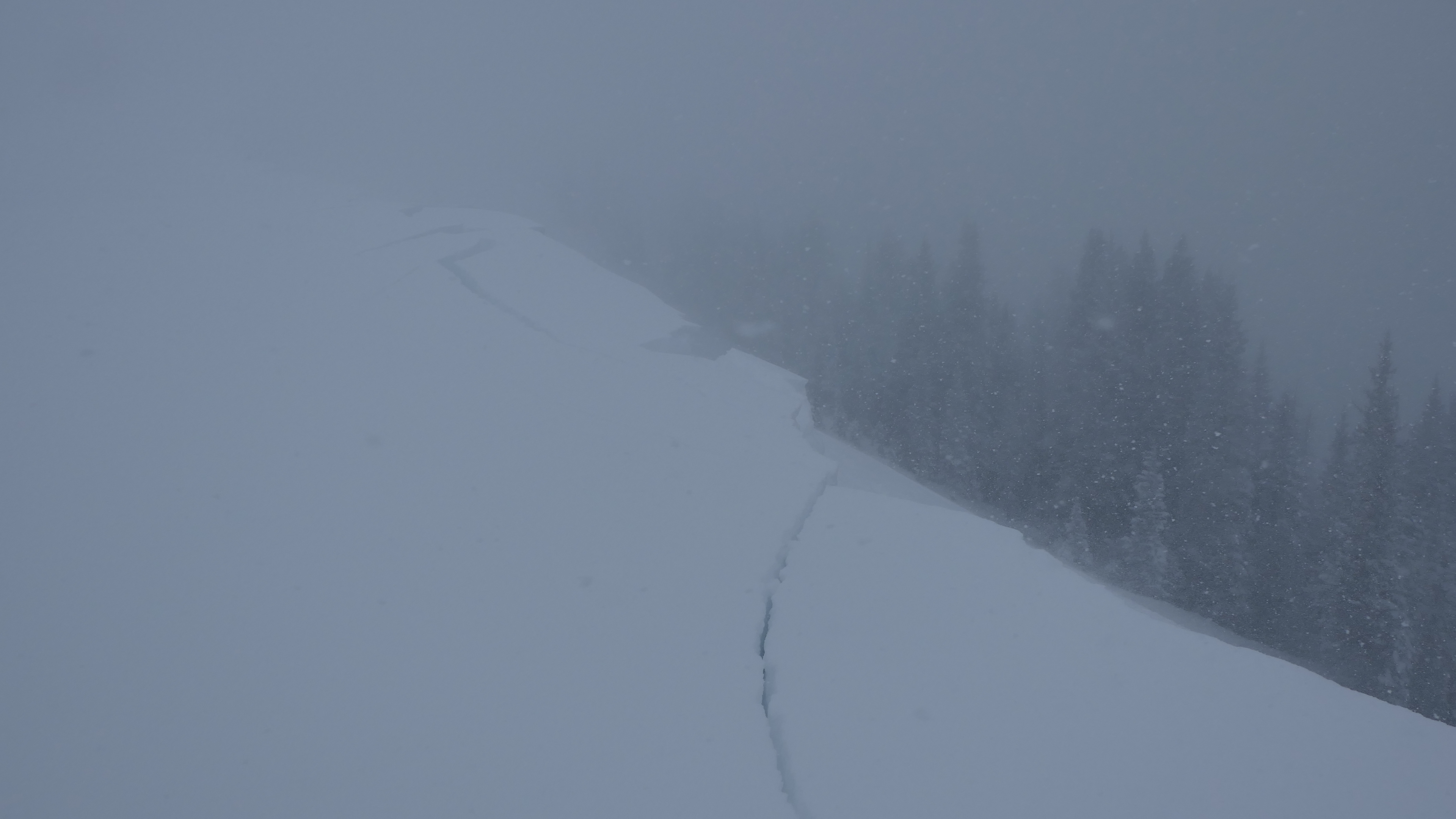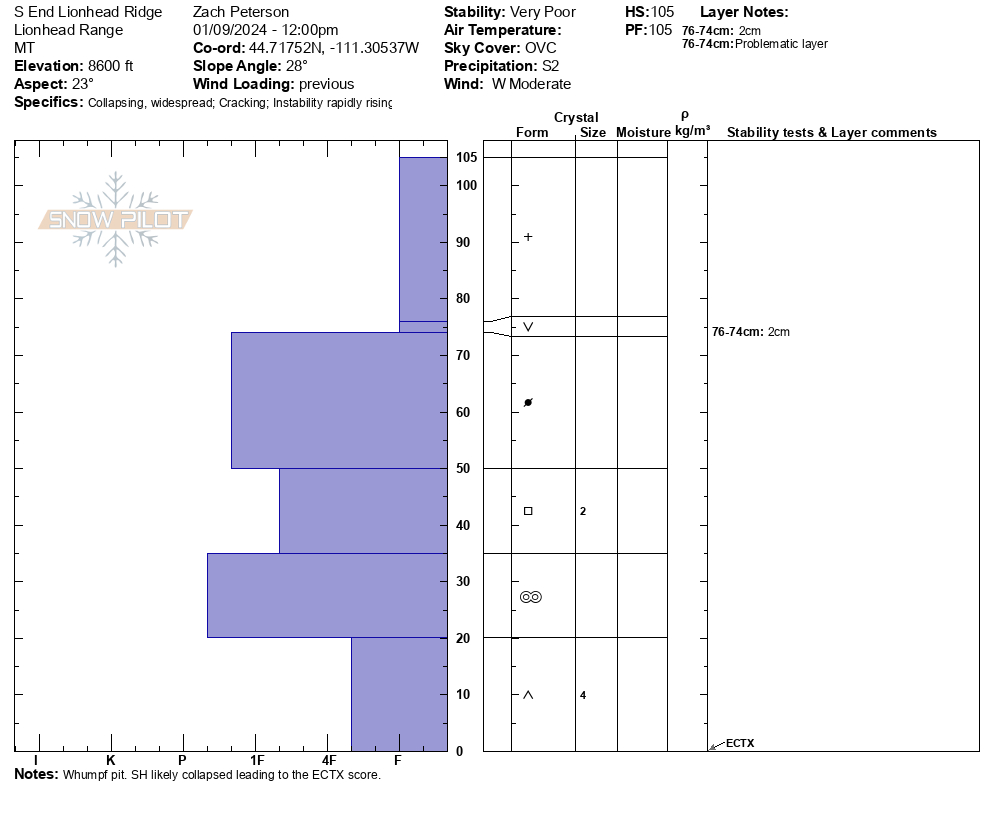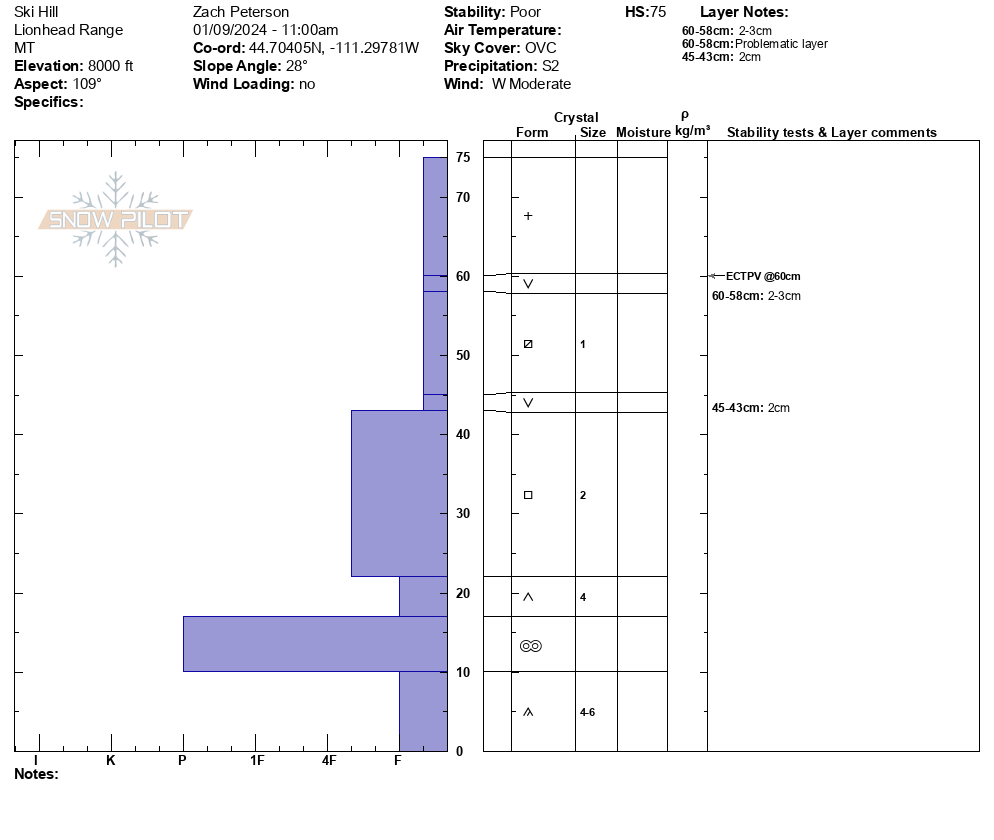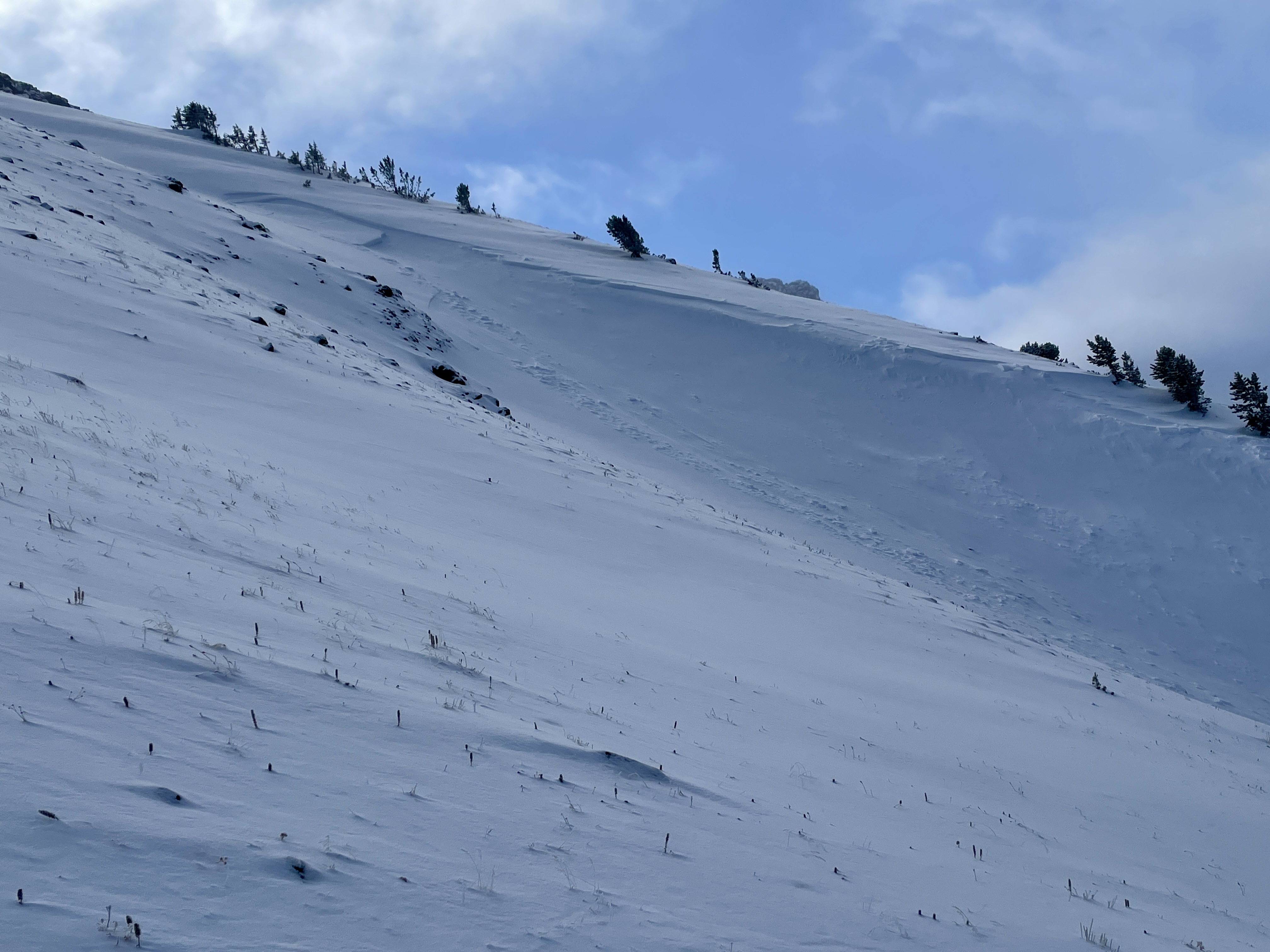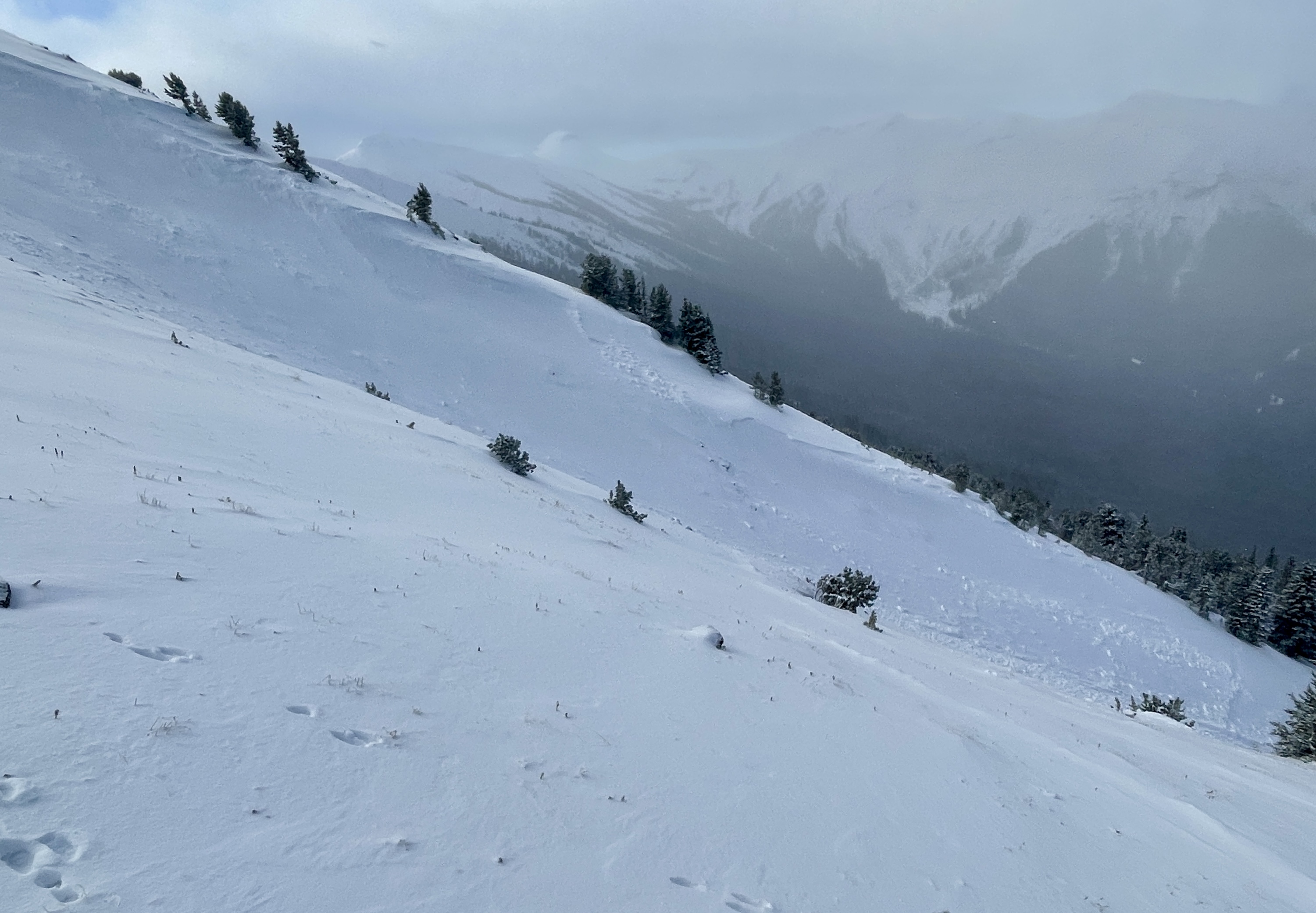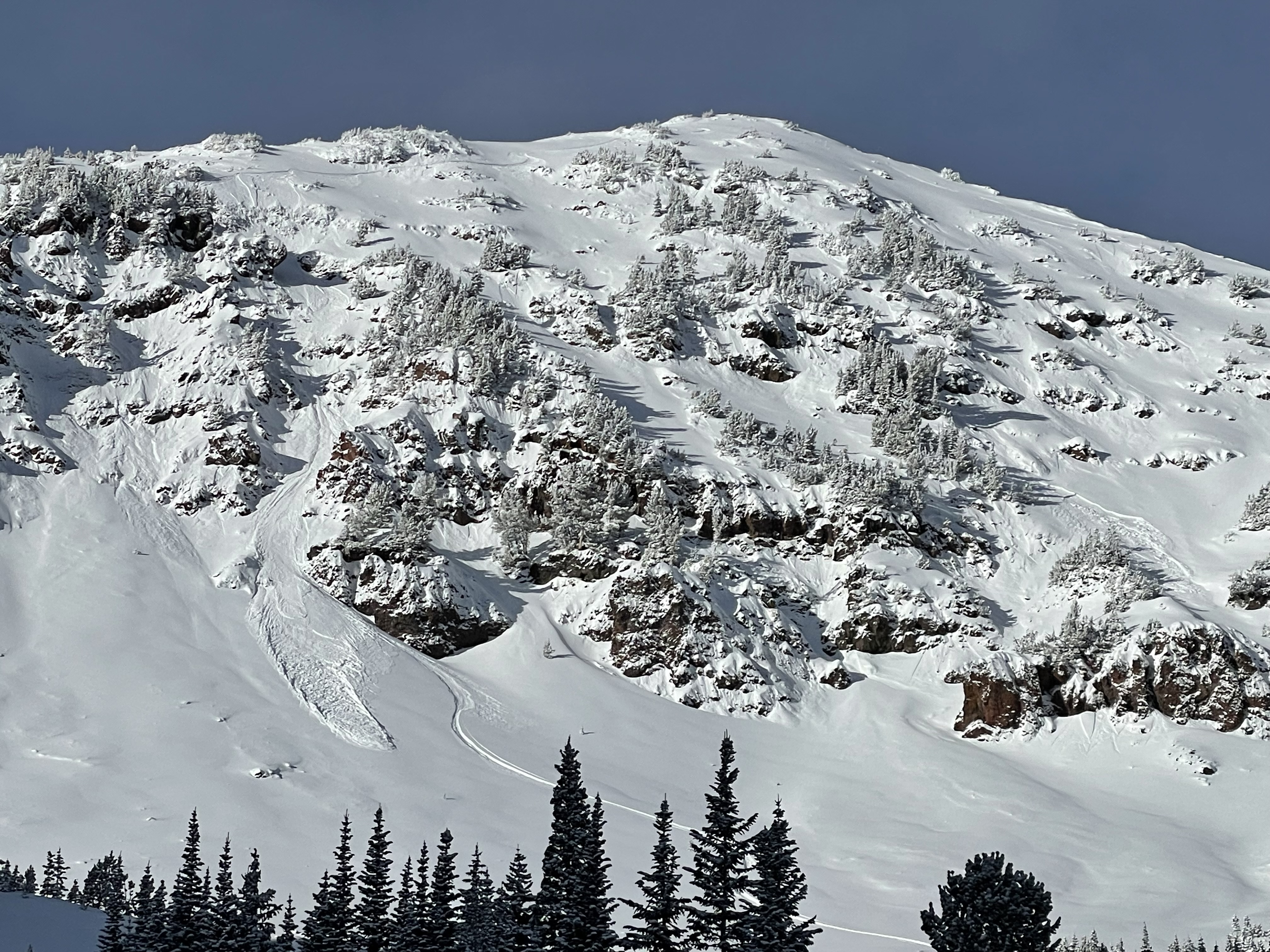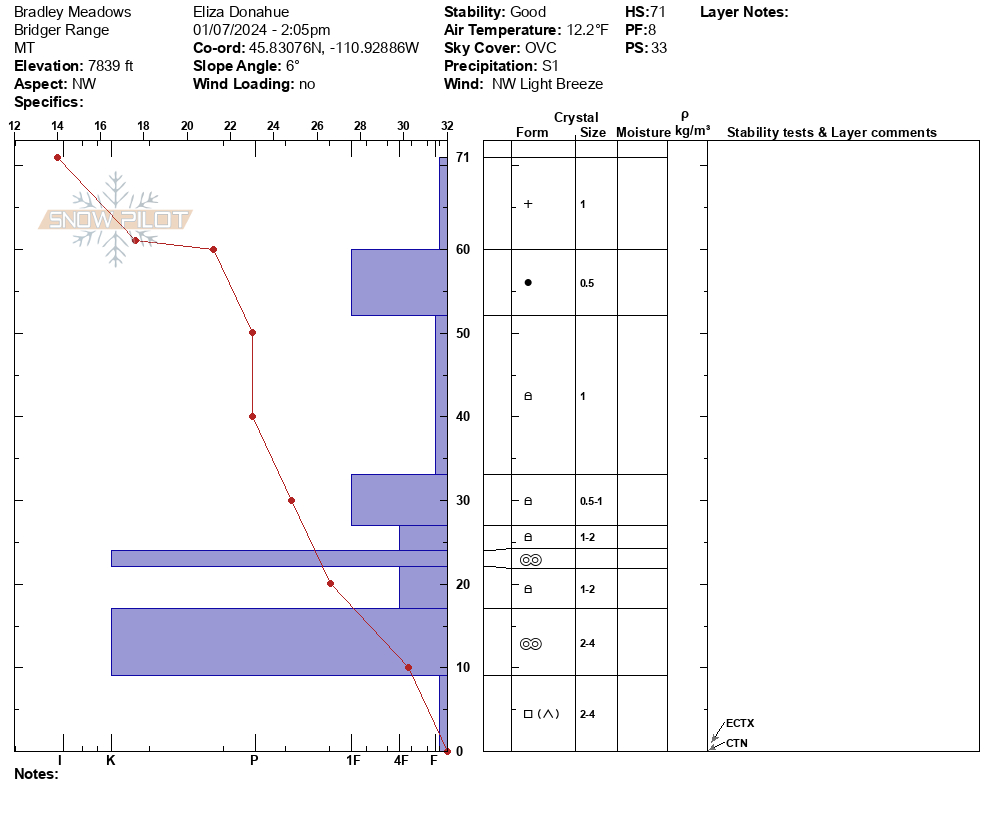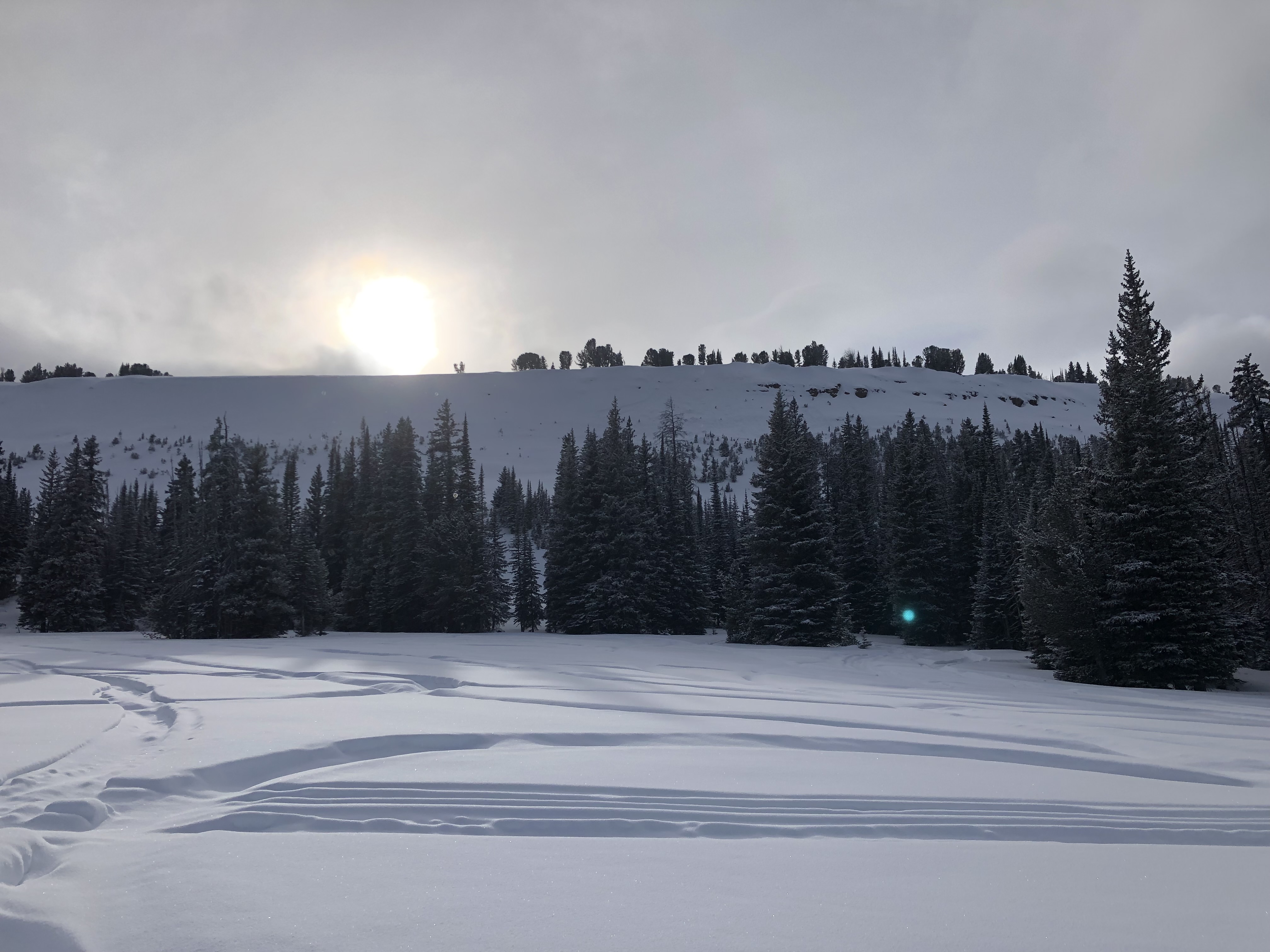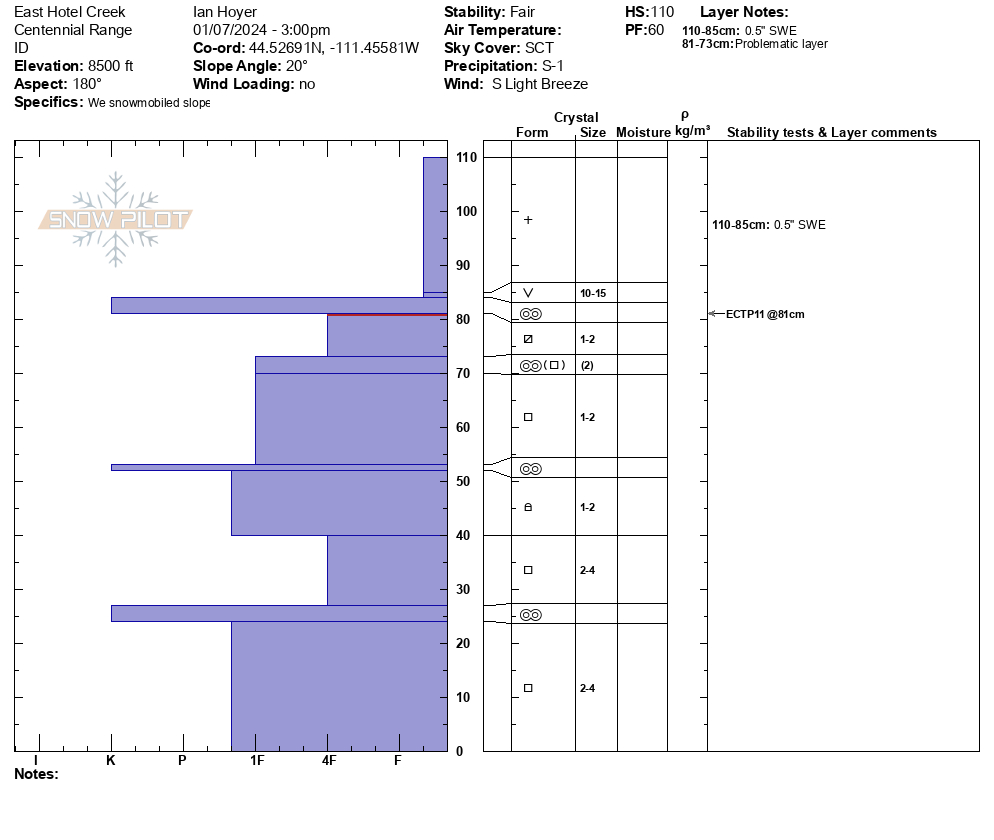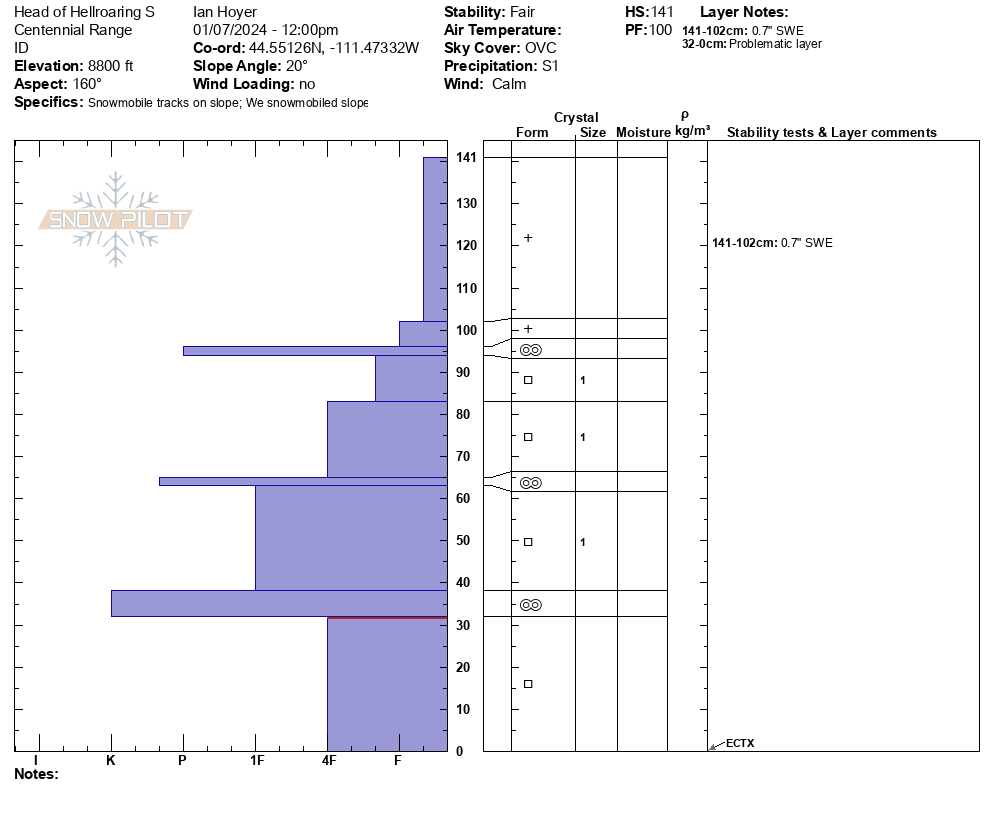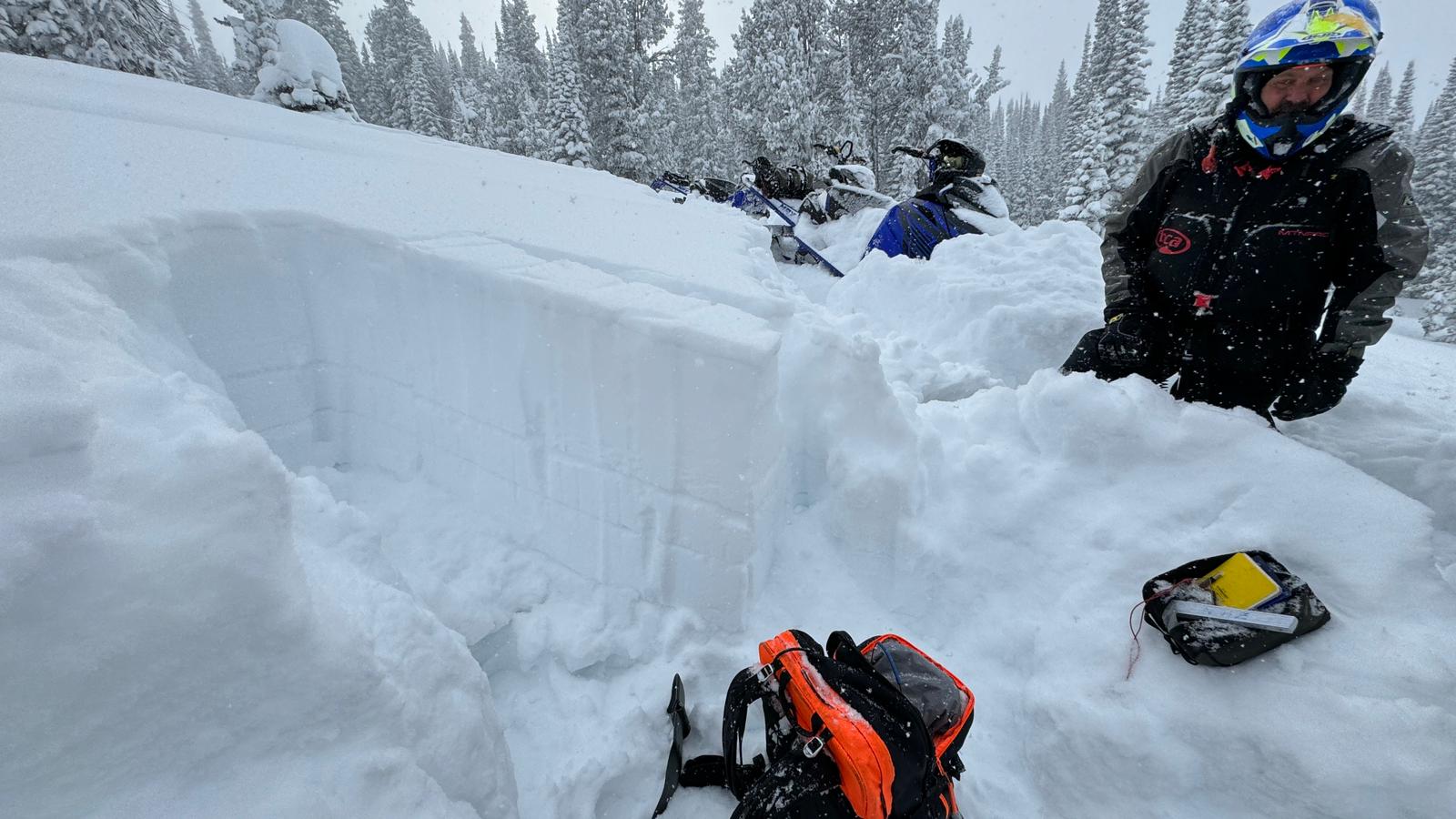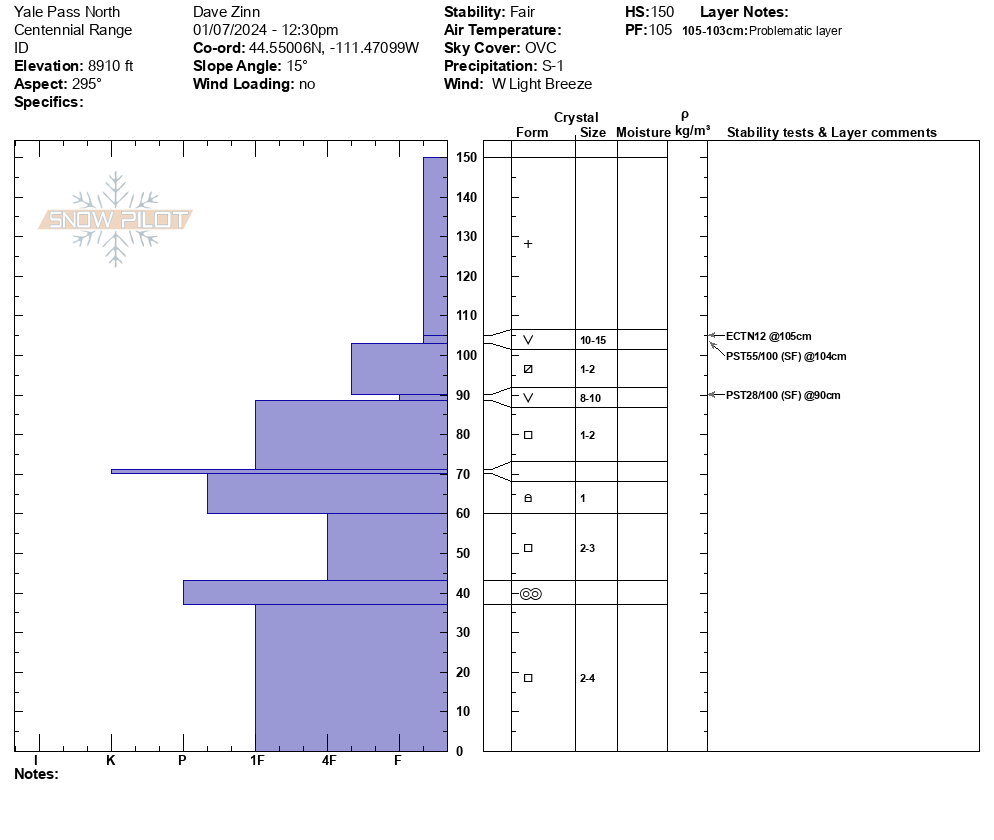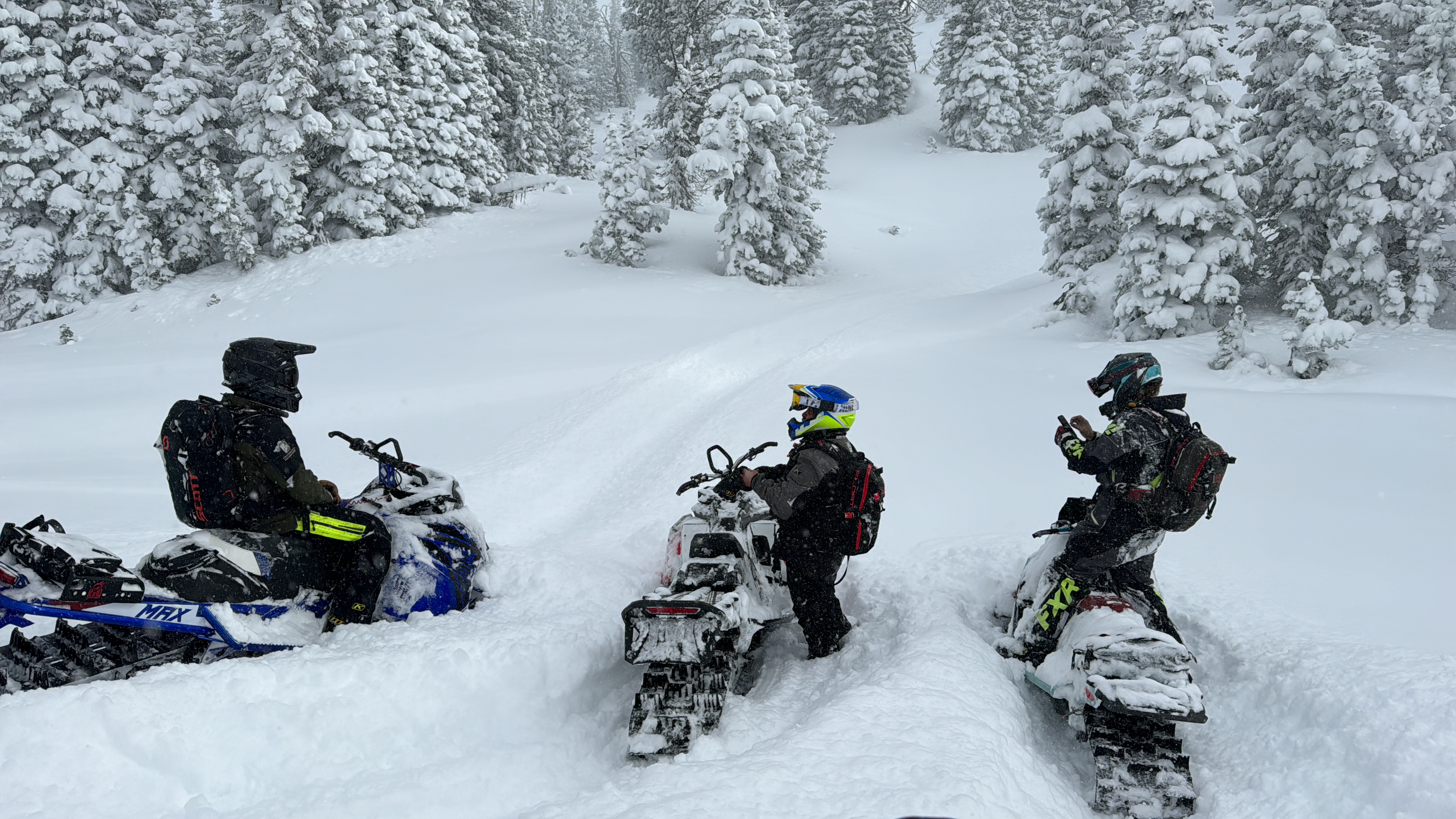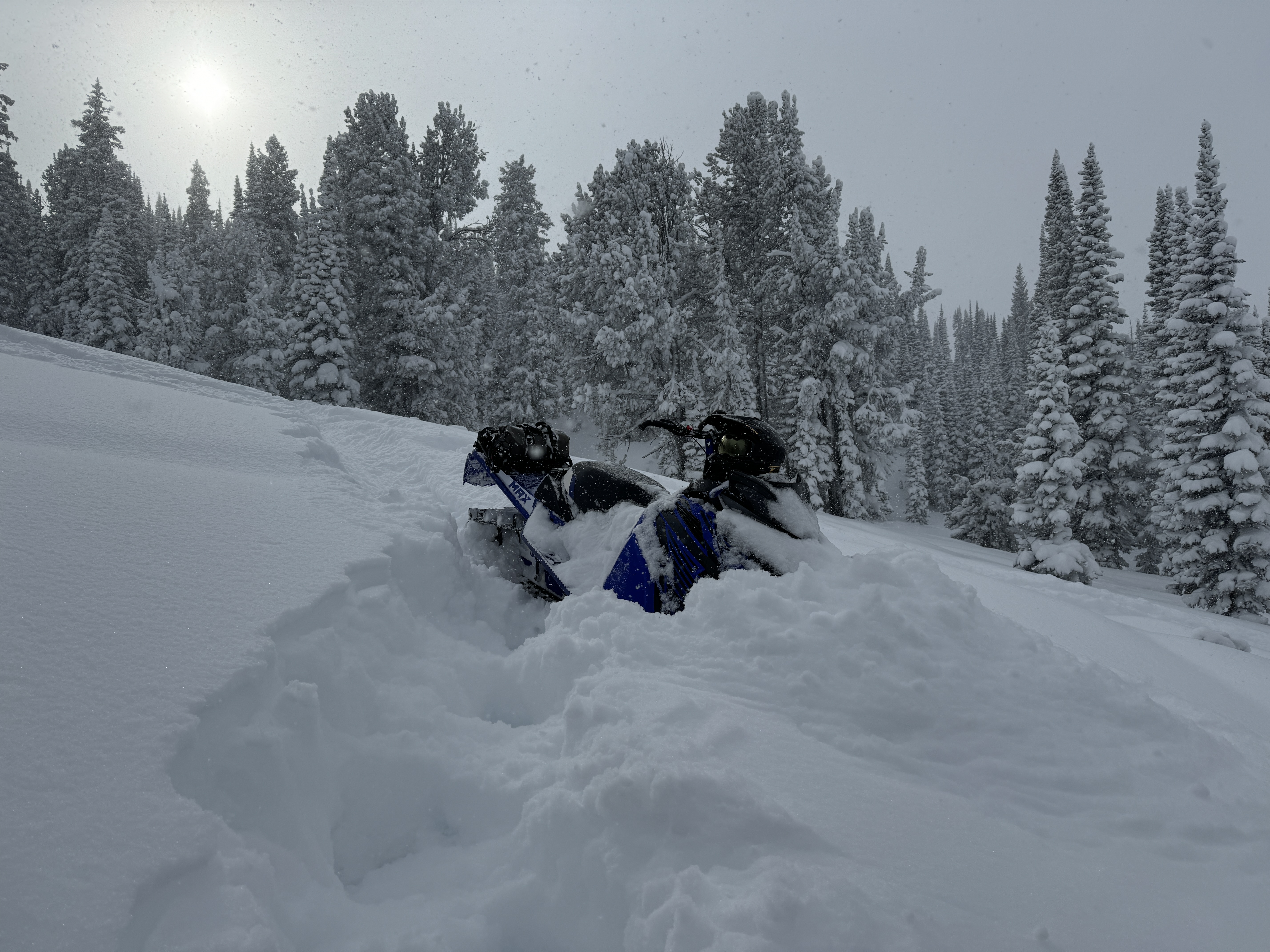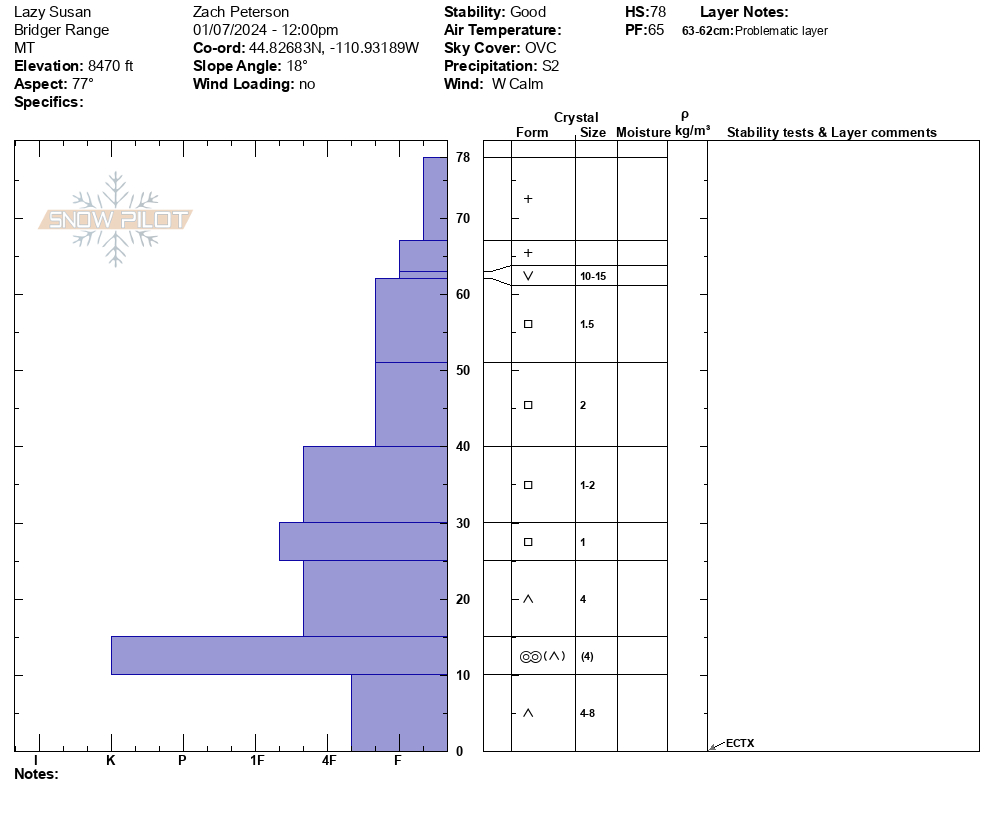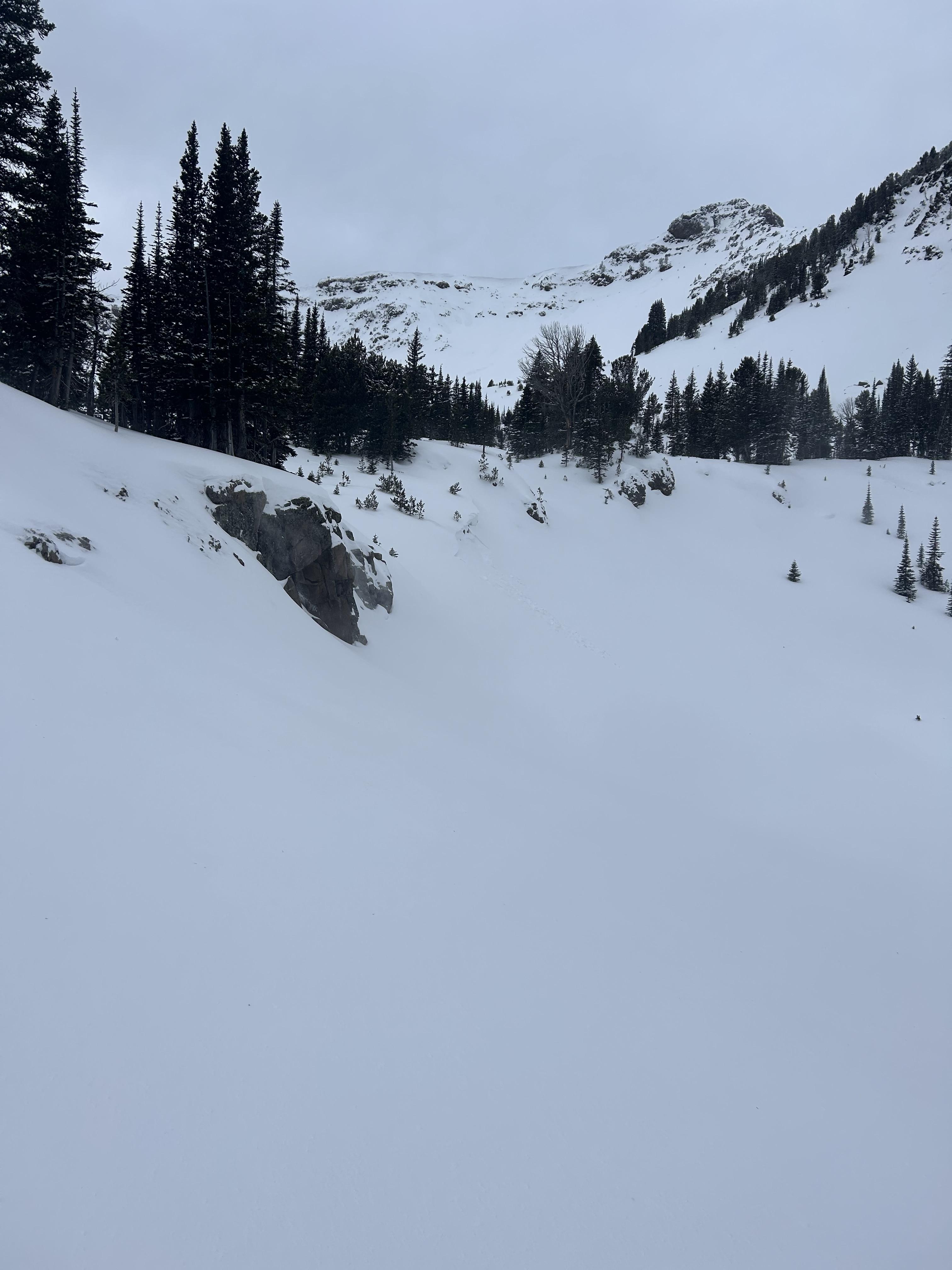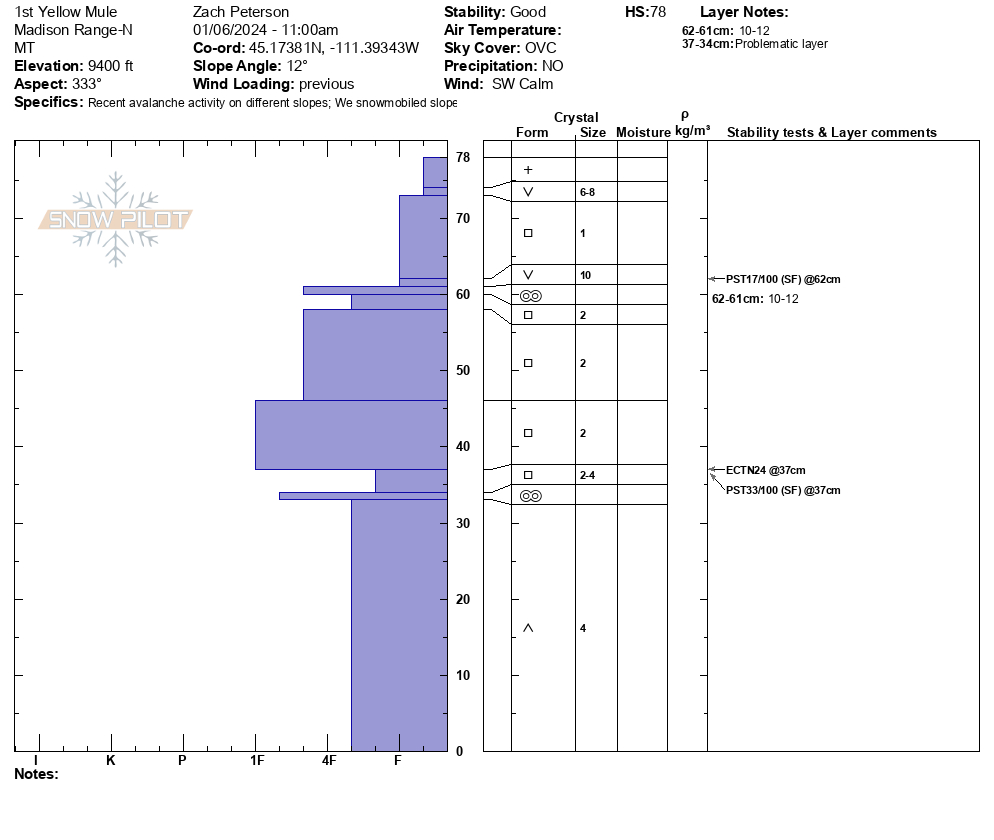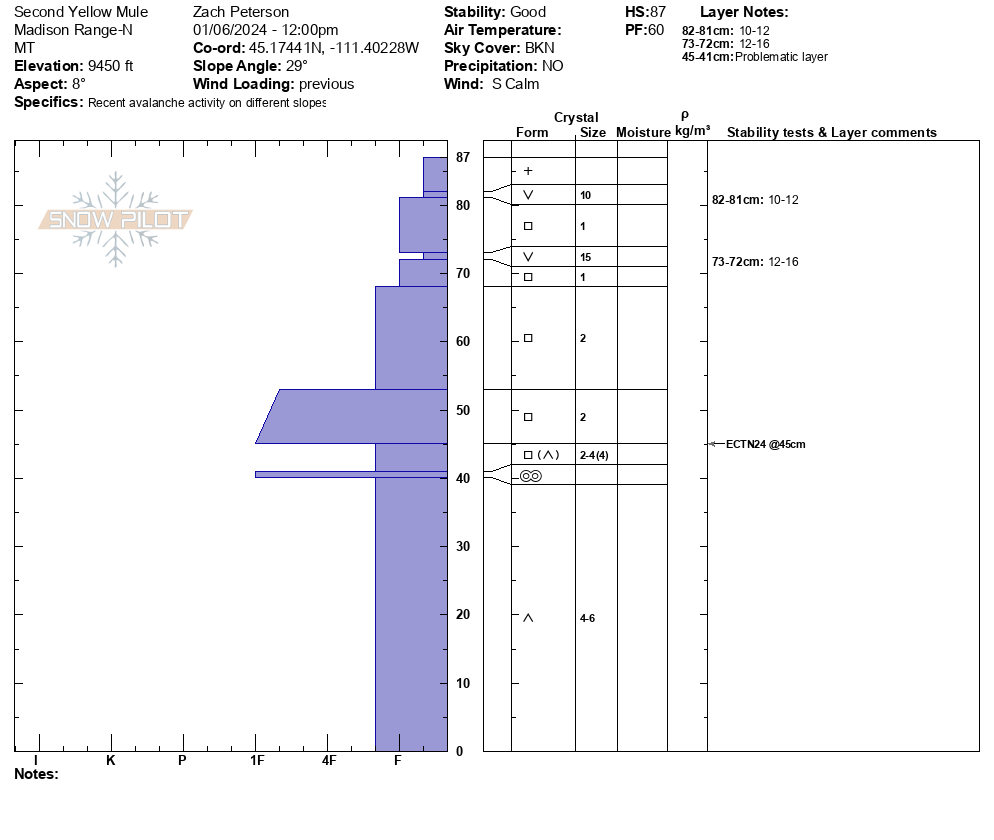Snow Observations List
Skied the S/SE face of Blackmore this morning. Had several large collapses lower in the basin, as well as the ridge. As NOAA predicted, winds started cranking at 10:30am which was time to go, most of the tracks in the area were covered up within an hour.
Full Snow Observation ReportFrom email: "Approx 35 cm new snow. W aspect 9750’ HS 117 ECTP 4 and ECTP 1 35 cm down on surface hoar. Trace of new snow today and getting colder fast. Shooting cracks were common outside the skin track up to 20ft and collapsing was frequent. "
Full Snow Observation ReportFrom BPG Obs blog input by ZP after talking to Reed.
Traveled into the Blackmore area to find some soft snow and compiled a number of observations. We performed a quick ECT on a NE facing slope at roughly 9000’ in a slightly wind loaded terrain feature and got a result of ECTX. In our pit we did identify the potential for a 3-5” slab consisting of the recent snow to avalanche in certain situations. We felt this was a manageable hazard as long as it was not on a large slope with exposure. While touring we also noticed a small avalanche (presumably natural) on the E face of Blackmore. It is in the attached photo. Later we dropped a refrigerator size cornice onto a steep slope and got a small pocket of the new snow slab to release confirming our earlier suspicion. While skiing one of our intended slopes, one of my partners skied over a small rollover and as he arrived at the bottom of the small slope a pocket had released above him and stopped just above where he was standing. The culprit was again the recent snow on top of older faceted snow.
Overall was a successful outing and we scored some good snow while managing the hazard we had identified.
Full Snow Observation ReportPockets of wind loaded snow throughout the gully. Slab thickness varied. It was steep enough to slide but was anchored well by trees and willows. The hasty test seemed that the slab failed on facets just below the recent storm snow.
Full Snow Observation ReportToured into Bacon Rind today. Winds were calm and trace amounts of snow fell through the day. Near the top of the Skillet we found 5" of new snow (0.5" SWE) sitting over large feathery surface hoar and in stability tests, we had very poor scores on this layer, ECTP2. The entire snowpack however is very weak, with soft faceted snow to the ground. Even with skis on we would sink to the bottom of the snowpack in many areas. This area did not get very much snow or wind compared to the rest of the S. Madison region lacking enough of slab to cause widespread signs of instability. At higher elevations, there would likely be enough of a slab to increase concerns as winds were stronger and recent snow totals are greater.
Full Snow Observation ReportWe toured up Tyler's Slope and dug at 9,200' on an west-facing slope. There was a 6" slab of snow sitting on fist hardness facets that propagated in our tests (ECTPV x2). Approaching the pit site we has some collapsing and shooting cracks. Continuing upslope we saw the cornices on the ridge had all broken and pulled out the wind-loaded pockets with one slope sliding 100' distance. These likely occurred last night.
We then dug on a east-facing slope to the north of the cornices and found 105 cm of snow and a 1 foot deep slab that broke in our test as an ECTP3. Low test scores, recent avalanche activity and cracking and collapsing was evidence of the snowpack's instability.
Full Snow Observation Report
The snowpack is still shallow on the Beehive side. Buried stumps and rocks were hidden.
Danger was the low end of Considerable and I was not psyched to get into steep terrain. We skied the going home gully (by the prayer flag location).
Our lower ridge has not been controlled or touched yet this year so very indicative the backcountry snowpack. It released sometime before the morning of Jan 10.
See picture.
Full Snow Observation ReportWe rode into Lionhead today towards Lionhead Ridge. Cloudy with consistent snowfall through the afternoon. The wind was out of the west and was blowing snow around at all elevations. We stopped at Ski Hill and dug on an east-facing slope at 8000'. While isolating our ECT we had a failure 15cm below recent snow on a well-preserved layer of surface hoar (ECTPV). From here we transitioned to skis and continued up to the ridge. As we approached the ridge we experienced frequent collapses and shooting cracks that extended 20 feet in front of our skis. At a rollover, while breaking trail there was a collapse, and 3" wide cracks shot in all directions and the slab moved a few inches downhill. If this terrain had been any steeper it certainly would have been an avalanche.
We continued towards the ridge and intentionally remotely triggered an avalanche on the steep terrain below the south end of the ridge. This avalanche broke 1000' wide, 18" deep, and ran 100 vertical feet to the trees. This avalanche likely happened on a layer of buried surface hoar similar to what we found in our pit on ski hill. Strong west winds at the ridgeline continued to blow snow and made for poor visibility but as we continued more cracking was seen and cornices were remotely triggered when walking near them.
Snowfall and strong winds continued making for poor visibility at ridgetop. We skied back to the snowmachine and portions of our skin track had been filled in by the steady wind and snowfall.
Full Snow Observation Report
We will go to an Avalanche Warning tomorrow for IP and Lionhead.
Yesterday (1/9) touring north of Cooke City I felt some large collapses and cracking on a heavily wind loaded, mid elevation slope. There was about 4-6 inches of new snow that fell throughout the day.
From Jake:
this was on cardiac hill, in Zimmer creek
Accessed Woody Ridge from Republic Creek, approximately 3 mi up. Turned around on a west slope at 9000', due to time of day. 8 degrees air temp,
Snowpack skied well and was supportable - 6-8" of new that seemed well bonded to old snow. 2 perceptible layers when probing with a ski pole. Lower layer much harder.
Downfall is still a hazard - not completely buried, but skiing was remarkably good, considering.
Mostly overcast day. Occasional wind gusts out of the SW, but mostly calm and cold.
Full Snow Observation ReportI saw debris from an avalanche in one of the southern Woody Ridge gullies. The slide appeared to be a recent windslab formed by the new snow over the past few days. Best guess it happened yesterday, and it appeared to be natural. The crown appeared ~8-16” from a distance, and was on the skier’s left side of the gully, the side that sees loading from wind out of the south. It ran a few hundred feet down the gully.
Full Snow Observation ReportSkinned up to Blackmore 01/08 to ski the East shoulder. Found that it had not snowed as much as it had in town the night before. Possibly 2-3” at lower elevations and 3-4” at higher elevations. There was some isolated wind loading in the basin at lower elevations and more widespread loading near the ridge tops. Did not experience any collapsing but did notice a few natural avalanches and one skier triggered avalanche near of the top of Blackmore. Looked as though it was a ski cut that popped the slab. Skied a low angle, non-wind loaded slope with a few lovely turns before smoking plenty of rocks on the way down the trail.
Full Snow Observation ReportToured up to the Bradley Meadow area and dug on a NW aspect at 7,839'. HS 71 cm, CTN, ECTX. Found a lot of faceted snow and a couple of firm melt freeze crusts near the ground. Full profile attached.
Full Snow Observation ReportFrom email: at Buck Ridge: "The difference in snow was astonishing within the 6 days. Last week pure sugar and facets lived on the surface sounding like crumply glass as you rode through. Today everything was far more dense and attempting to support the sleds on The terrain just beyond the alpha angles enough to have some over the hood pow play without bouncing off rocks. Between wind and finally getting some snow with moisture in it, low angle areas outside the trees are racking up the inches. It snowed ~2" while we rode.
There's a substantial crunch layer to north faces now in McAtee just off Muddy and visible in trenches dug to the ground. Beaver and 1st towards the ridgeline trail held far more snow - as you drop lower into each basin the quality and depth diminishes. 2nd , 3rd and McAtee must have been just out of the main drop of the last storm."
Full Snow Observation ReportWe rode up to the head of Yale Creek, down a bit into the head of Hellroaring Creek and then returned via the East Fork of Hotel Creek. The depth of new snow increased dramatically with elevation from approximately 8" (0.5" SWE) at 8000 ft to 18" (0.7" SWE) at 9000 ft. The new snow had little cohesion.
We found buried surface hoar on both shady and sunny slopes. Sunny slopes had multiple melt-freeze crusts interspersed with weak facets throughout the pack. On shady slopes the lower snowpack was entirely faceted. We had an ECTP11 on facets just below the old snow surface on a S facing slope. Otherwise our results were ECTX and ECTN with slab fracture in Propagation Saw Tests (likely because neither the facets or new snow were cohesive enough to act as a slab in our tests).
Wind, settlement or more snow could quickly make for a cohesive slab. When that happens, with so much new snow and such weak snow beneath it conditions will rapidly become unstable.
We saw no avalanche activity and had no cracking or collapsing.
Full Snow Observation ReportWe went to Bridger Bowl today and walked along the ridge to the Ramp. The west wind was calm and there wasn't any new snow being transported while we were walking. Snow remained mostly light (S1) with short bursts where snowfall increased (S2). We stopped at the top of Lazy Susan to dig, we found 6" of new snow sitting over old weak snow. Despite being just below the ridge this area was not wind-loaded and we found a well-preserved layer of 10-15mm surface hoar. We had no results in stability tests, ECTX HS: 78 cm. During the descent of the ramp we triggered multiple sloughs in the new snow however they did not run far and were not big.
Full Snow Observation ReportWe toured up into the Maid today to see how conditions were looking. Low snow down low and starting to stack up in the basins. We dug a pit on a East aspect at 9500, the pit showed a 100cm deep snowpack. Large facets were found from the ground up to 40cm. There was a hard crust layer at 40cm, above the crust layer was a dense slab that hasnt turned completely rotten yet. The snowpack was dense above the crust layer, but less consolidated towards the surface (upside down). We had an ECTN 21 at 40cm. We also observed numerous wind slabs that relaeased naturally during the day on N-NE aspects near ridgelines (6-12 inch crowns). We also found touchy wind slabs on micro terrain lower in the basin.
Full Snow Observation ReportRode up the Taylor Fork today. Broken sky at the trailhead, quickly moving to overcast and then snow (S1) by 10-10:30. Sustained strong winds from the S. HS 80-120cm at 9200’, entirely facets capped by varying thicknesses of slab- 2-30cm thick. Widespread large surface hoar in protected areas.
Slabs were touchy, no other signs of instability noted but vis was terrible. Good riding at upper elevations in sheltered zones. Road is a terrifying mix of whumps, rocks and ice.
We rode into Buck Ridge toward McAtee Basin, partly cloudy with no snowfall during the day, but 1-2" from yesterday's storm (01/05). The wind was calm in the morning but quickly increased by early afternoon. We dug at First Yellow Mule on a northwest-facing slope at 9400', HS: 74 cm, ECTN 24 on faceted snow 37cm above the ground. In the upper portion of the snowpack was a layer of well-preserved surface hoar covered by snow that fell on the days before Christmas. Near the top of our snowpit, we found another surface hoar layer that was capped by the most recent storm. We continued to the top of Second Yellowmule and dug again on a similar aspect and elevation and had similar test results. (HS:87cm, ECTN 24 45cm above the ground). Both layers of buried surface hoar were present here as well.
In Second Yellowmule, we saw a natural avalanche that was 10-12" on a wind-loaded north-facing slope along with several smaller loose snow avalanches along the same face. On wind-loaded test slopes, we found that recently formed wind drifts were easily triggered. In areas that were missing a wind-slab loose snow avalanches were still sensitive to triggers. These avalanches would start in the new snow but entrain the weak faceted snow below resulting in larger avalanches than what recent storm snow could produce on its own.
In McAtee Basin on another test slope, remotely triggered a test slope, which broke on a layer of buried surface hoar 4-6" deep. Around the corner, we found another recent avalanche, 6-8" deep, that likely broke as we approached it from the top.
The wind blew through the majority of the day and while exiting our previous tracks had been blown over in some areas and active wind loading could be seen.
Photos and Video coming soon!
Full Snow Observation Report
